A Culture Lover gets to pick from the best UNESCO World Heritage Sites from Europe. These are stunning and off the beaten European destinations with intense cultural experience.
What intrigues me the most about Europe is its astounding Cultural Diversity. I mean, I am from India and here the landscape and people changes every 500 KM but Europe is a different ball game altogether! Birthplace of renaissance and democratic ideas alongside intense political upheaval dating back from the Greek empire to the colonists of the recent past, Europe is a medley of mankind’s collective learning experiences. It sure reflects in the incredibly rich culture of an otherwise small continent.
For a first time traveler in Europe, who also loves to plunge deep into cultural experiences, Europe often becomes synonymous with Paris and London. But wait before you take a call. Trust the World UNESCO List to come to your rescue. Here is a list curated with the suggestions of the world’s finest travel bloggers, who pick their favourite European destinations from the UNESCO site for a Culture lover.
Cologne Cathedral, Germany
By Emma from Emma Adventures
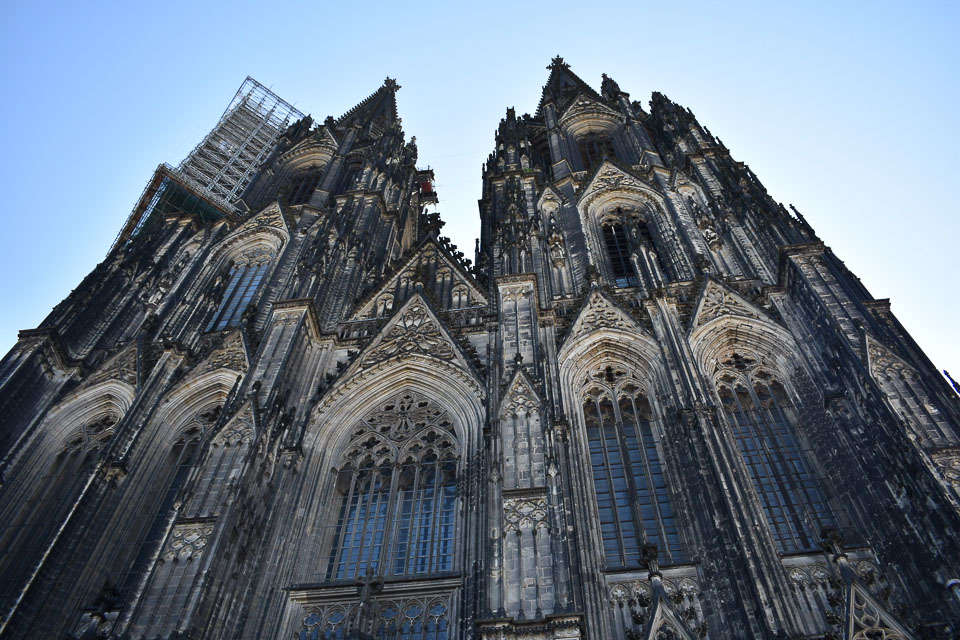
Cologne Cathedral is a UNESCO World Heritage site in Cologne, Germany, and is one of the most impressive cathedrals in the country. The base for the famous gothic cathedral was formed way back in 1248 and was originally built for Three Wise Men would had come to Cologne from Milan, Italy at the calling of Archbishop Rainald von Dassel. It quickly turned in to one of the most important sites of Pilgrimage in Europe.
The Cathedral didn’t actually finish being constructed until 1880, but since then the twin towers of Cologne Cathedral have dominated the city’s skyline and draw tourists to the German city all year round. Cologne Cathedral was named a UNESCO World Heritage site in 1996, and today it remains Germany’s most visited attraction, and can attract up to 20,000 visitors each day.
It’s easy enough to visit Cologne Cathedral. Situated in the centre of the city, it’s hard to miss. Open from 6am-9pm daily in summer and 7pm in Winter, you can explore the impressive interior of the Cathedral. If you are up for a workout, you can opt to climb the 533 stairs which lead to the top of one of the towers for impressive views of the city. You can do this daily from 9am-4pm. If you want the opportunity for photos without hundreds of tourists cramping your style, wake up early to capture some sunrise shots.
Also read: 15 Intriguing Historical Old Towns of Europe!
Durham Castle and Cathedral
By Tammy from Travelling Tam
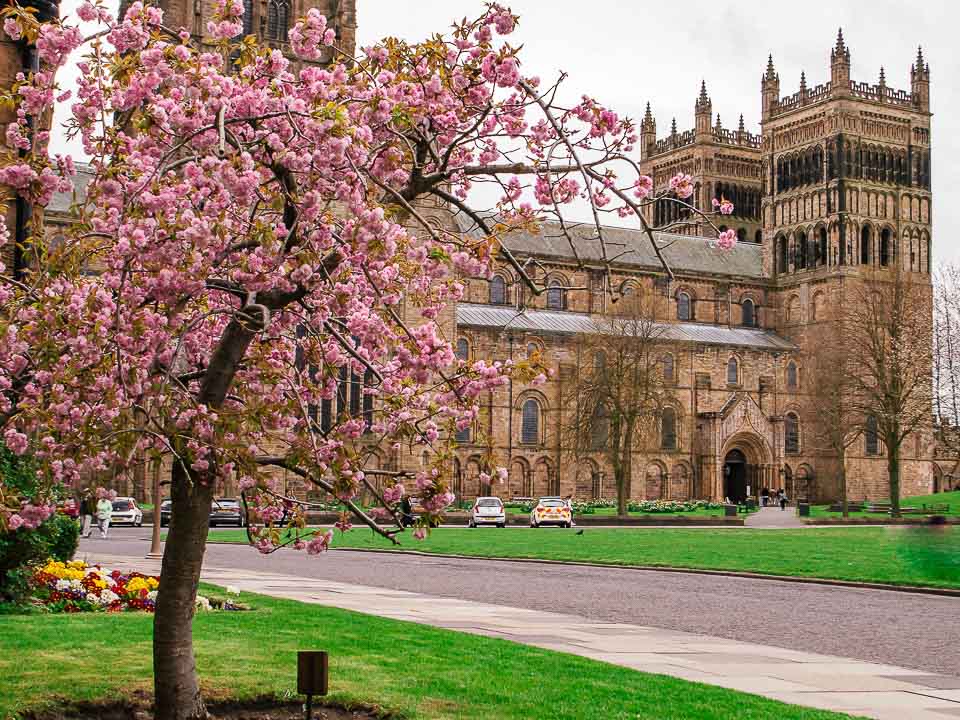
Durham Castle and Cathedral, built in the 11th and early 12th century, are one of the finest examples of Norman architecture in the whole of England. Both buildings, located across a grassy square from each other, are testament to the importance of the early Benedictine community at the time. So it made sense that in 1986 they were officially recognised – and of course protected with a UNESCO listing.
Durham Castle is actually the only fortress to have never been attacked which is why it is still in fantastic condition, even to this day. Parts are open for the public to explore whereas the rest of the castle is private as it houses Durham University students – lucky them!
The Gothic architecture demonstrates the incredible innovation at the time and is the historical gem in the crown of Durham. Even just admiring the castle from the outside is a true spectacle.
Walk just beyond these listed buildings and you will find stunning stone cottages and terraced houses with classic English country gardens, built at a similar time. Many of the old buildings are now university properties, brilliant tea rooms and quaint shops. A little further down the cobbles lanes you can of course find many classic English pubs and retail shops.
Durham is an extremely photogenic city rooted in religious and ancient cultural significance. It makes for a great weekend away destination in the very underrated north of England.
Notre Dame Cathedral, Tournai, Belgium
By Bhushavali from My Travelogue by Bhushavali
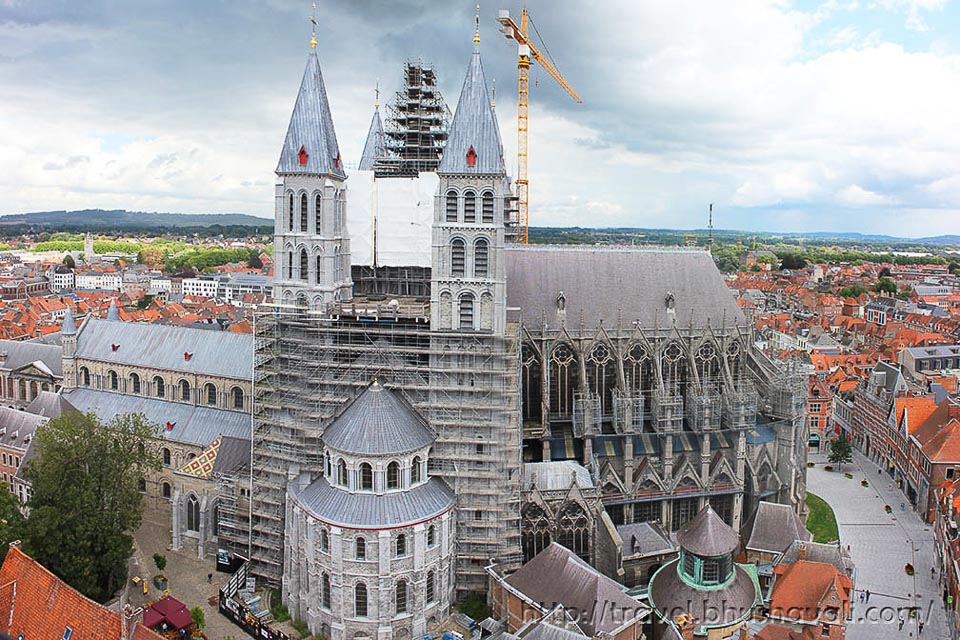
Belgium is a very small country but it’s the home to 13 UNESCO World Heritage Sites and the town of Tournai, close to France has 2! 56 Belfries all over France and Belgium are protected by UNESCO. One of it is here in Tournai. The other is the Notre Dame Cathedral.
The origin of this church is from 5th C CE. However the major construction happened in 12th – 13th C CE. In 12th C, when King Philippe Augustus became the self-appointed king, he ruled the then French country with Tournai as capital, thus making Tournai, effectively, the birthplace of France!!! The architecture is fascinating and has been added on, as time went by. The nave is Romanesque, the altar is Gothic and the transepts are a beautiful mix of the 2 styles!
Its currently under major restoration though! What happened in 1999 was crazy. There has hardly been any tornadoes in Belgium, but there was one in 1999 and it was so bad that one of the towers of the Cathedral, moved by 80cm!!! While obviously, now, the towers cannot be climbed, it is possible to climb the Belfry just beside it to get an impeccable view of the Cathedral from almost the same height. The Cathedral is 83m tall and Belfry is 72m.
Apart from these, the town has many more historic structures incl. Pont des Trous – a bridge of 13th C, Henry VIII Tower of 16th C, fortification walls, ruins of Fort Rouge, Victor Horta houses and more!
The Grand Place, Brussels, Belgium
By Constance from The Adventures of Panda Bear (Follow her on Instagram @adventuresofpandabear)
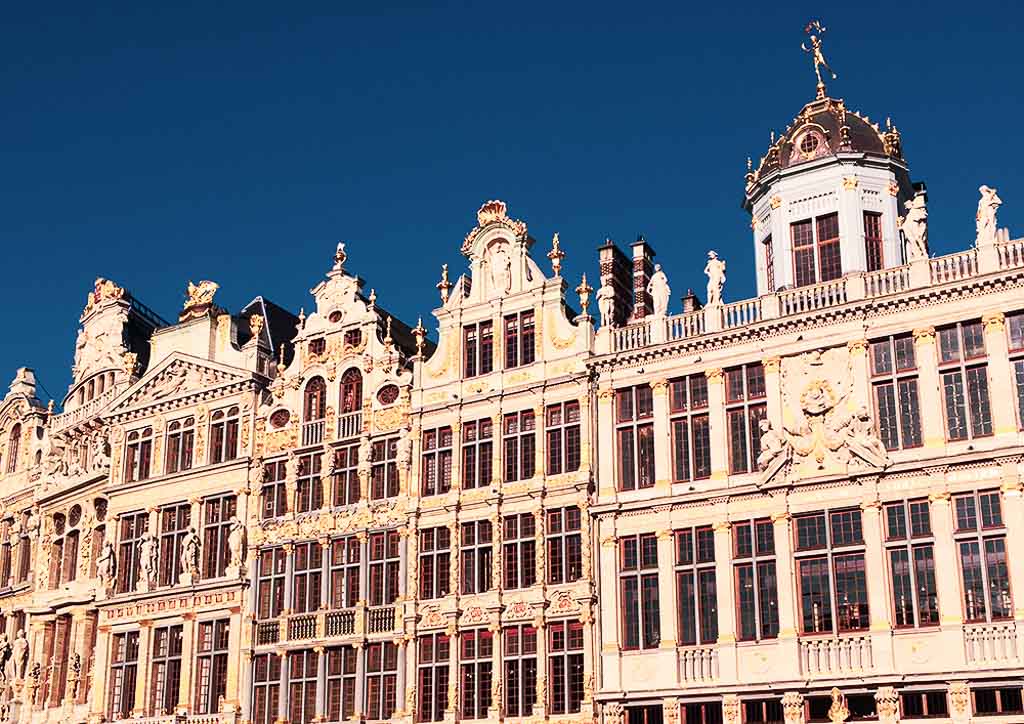
The Grand Place, also known as Grote Markt in Dutch is one of the most popular places to visit when spending a weekend in Brussels. Surrounding this public square are gorgeous guildhouses, the Brussels Town Hall, and the King’s Hall or Breadhouse which is now home to the Brussels City Museum. In 1998, The Grand Place was designated a UNESCO World Heritage Site and is considered one of the most beautiful squares in Europe.
As the central plaza of Brussels, this UNESCO World Heritage Site is best known for its beautiful floral carpet that appears every 2 years during the month of August. The tradition began in 1971 and during this time, a million colorful begonias are arranged into a technicolor pattern covering 19,000 square feet or 1,800 square meters for a few days.
The Grand Place is also where the Ommegang of Brussels takes place for two days around the months of June and July. This annual event is a medieval pageant offering a historical reenactment of Emperor Charles V and his son, Phillip, entering the city of Brussels in 1549.
Aside from the historical Ommegang, history fiends will also love the Brussels Town Hall and the Brussels City Museum. Both buildings themselves are full of history and the Brussels Town Hall actually offers guided tours through the building that offer a plethora of information about the building itself as well as the city. The Brussels City Museum is a history and culture museum about the city from its founding to modern times. Its exhibits consist of various artefacts ranging from paintings to sculptures, tapestries, engravings and more.
Dubrovnik, Croatia
By Tea from Culture Tourist
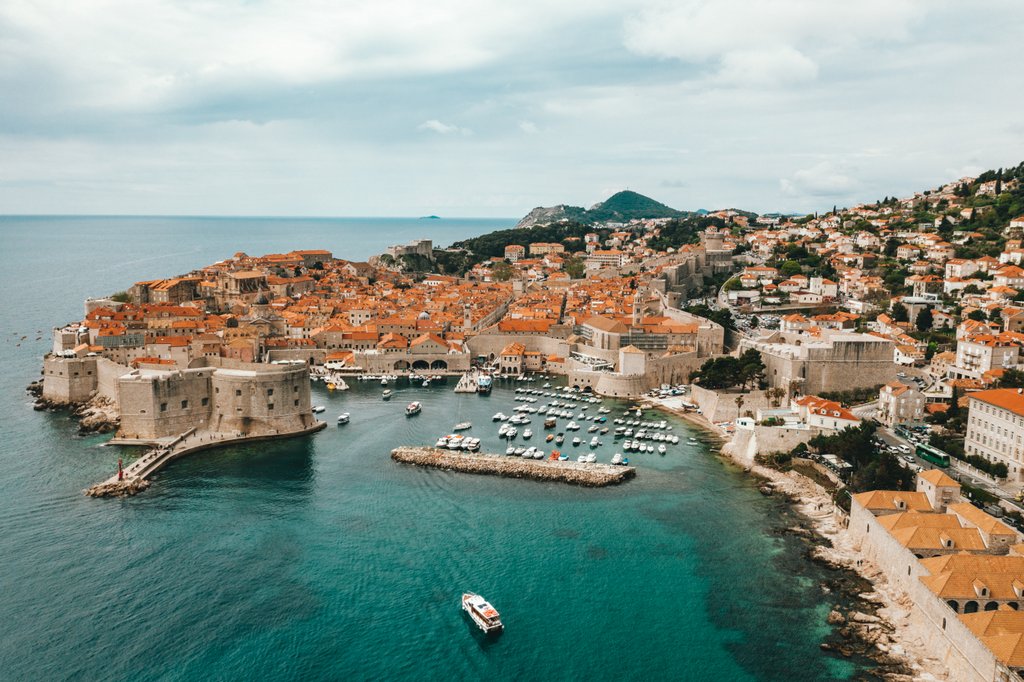
With its historical buildings and monumental Medieval city walls, the old city of Dubrovnik deserved its place on a list of the UNESCO World Heritage sites by every right.
It’s a rather small town, so spending a weekend in Dubrovnik would be just enough time to explore it. A good tip of advice is to avoid visiting it during the high season, between June and August because it’s crowded with tourists during that time.
Located at the very south of Croatia, Dubrovnik has some fascinating history. During most of its past, it was an independent state – the Republic of Ragusa. Its citizens were mostly involved in the maritime trade. They were also quite important during the 15th and 16th century as international diplomats.
You can see even today how important the city used to be when looking to some of its fantastic architecture. Walking around Dubrovnik walls is an incredible experience during which you’ll have a great view of the city and the Adriatic sea.
Some of the most important buildings in Dubrovnik are Sponza Palace, with the old Clock Tower next to it. Be sure to visit the Franciscan Monastery with an old, but still functioning pharmacy from the early 14th century. Rector’s Palace was the seat of the government back in the time. And you can learn more about it by visiting a museum located inside of it.
The main street in Dubrovnik is called Stradun, and this is where many small shops and cafes are. However, the best way to experience the city is by getting lost in some of its smaller narrow streets and just enjoy in the feeling like you’ve stepped back into the past.
The Camino Frances
By Campbell & Alya from Stingy Nomads
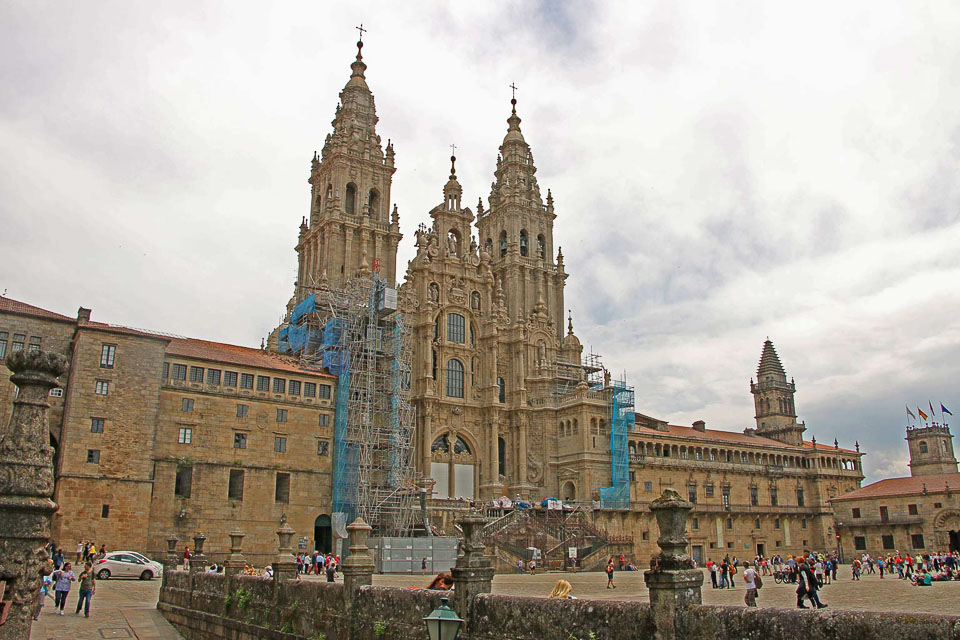
The Camino Frances is the most popular pilgrimage route of the Camino de Santiago network with thousands of people walking it every year for the last eleven centuries. In 1993 the Camino Frances and the routes in Northern Spain (some parts of the Camino del Norte and the Camino Primitivo) were declared a UNESCO World Heritage site. The history of the Camino dates back to the IX century when in 814 (820 according to some sources) the tomb of apostle St.James was discovered.
According to the legend the Apostle was killed by beheading in Jerusalem in 44AD. Apostol’s followers transferred his body by the sea to Galicia where he was buried in the place that is nowadays known as Santiago de Compostela. Almost immediately after the rediscovery of the tomb pilgrims from all over Europe started coming to Santiago. Most of the pilgrims on the way to Santiago follow the Camino Frances.
The French Way is a 770km route that starts in France in a small town St.James Pied de Port on the border with Spain and finishes in Santiago de Compostela. The route crosses four Spanish regions; Navarra, La Rioja, Castill and Leon and Galicia. It takes between 30 and 34 days to complete the Camino.
The entire route is marked with two traditional Camino de Santiago symbols, yellow arrows and shells that indicate the direction. There are countless churches, chapels and monuments along the route dedicated to St.James the Camino is a real treasure box for history and culture lovers. Among the highlights of the Camino are cities like Pamplona, Logroño, Burgos, León and Astorga. The Camino de Santiago has been an important part of European culture and history for many centuries.
Prague
By Albi from Ginger around the globe

Prague is currently a very popular tourist attraction with charming historic center. The truth is that the whole historic center is part of UNESCO.
You can find there sights like apostle clocks, Pulver tower, Charles bridge or Prague castle. All of this is part of the historical center and it has a great story with historical significance behind it.A long before Bohemia (today known as Czech republic) belong to Habsburg monarchy, Bohemia had it’s own kings and queens. They were usually subordinate to the Rome empire, but they had their own coronations. And all of the coronations started by Pulver tower.
Right next to it was a house, a mayor office, I believe, where the king had to spend a night before the coronation. Once he woke up, him and his parade had to march to the Prague castle. They went through Old town square, where you can see the very famous Apostel clocks. In the Old town square, they were usually welcomed by the crowd. Then they continue towards Charles bridge. Which is currently the oldest bridge in the Czech Republic, and lastly, they went to the Prague castle where the coronation took part n St. Vitus Cathedral. It was a big tradition up to the 16th century.
If you want to visit Prague, you can still see all of these things just by one long walk. You won’t see the king, but it is easy to spot why this road had such a big significance to it. Besides, you can very well see the whole city, once you finish the route and get the view from Prague castle.
Bruges, Belgium
By Mayuri from ToSomePlaceNew
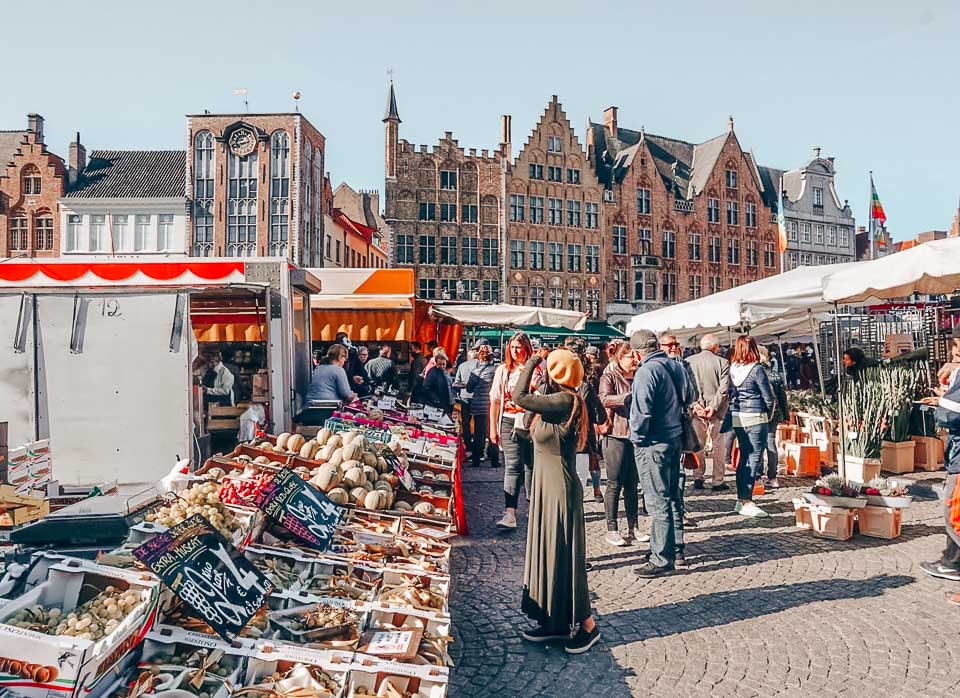
Bruges is a stunning city in Belgium. This city is characterized by canals, Flemish architecture, market square and medieval forts – and many UNESCO World Heritage-listed sites.
Bruges has a very small town cultural vibe, which will take your breath away. The central square is a UNESCO World Heritage site with the colorful Grote Markt and surrounding buildings.
Watching the hustle-bustle of the market-place is like living a chapter of medieval Europe – merchants and guilds selling their wares.
The Grote Markt hosts Christmas here, every year. There are wooden chalets surrounding a glittering ice rink, where skaters and visitors enjoy the festive lights.
Near the Grote Markt, are many historical buildings including the Belfry tower, which towers over the market. The Belfry of Bruges was used as an observation post for spotting fires and other dangers. Today you can take the 366 steps to the bells at the top for amazing city views.
Located very nearby is the Burg Castle. Both the Belfry and the Burg castle are listed as UNESCO World heritage sites in Bruges, so definitely include them in your Bruges itinerary.
One of the coolest and romantic things to do in Bruges is to take an hour canal tour for 8 euros, to explore the best sights of Bruges. This is a must-visit activity when you are in Bruges, and I highly recommend it. It is for a good reason that Bruges is called the Venice of the North, you have to have a canal ride to understand why.
Rila Monaster, Bulgaria
By Krasen from Journey Beyond Horizon (Follow her on IG @journeybeyondhorizon)

In the Balkan Peninsula’s highest mountain called Rila, in a deep valley, there is a hidden gem. This is Rila Monastery, one of the largest Christian Orthodox monasteries in the world. Surrounded by high alpine summits and dark gorgeous forests, it hides a lot of secrets from the past. At the same time, it keeps a rich treasure of the Bulgarian traditional culture.
The foundation of Rila Monastery dates back to the 10th century. A hermit, called Ivan Rilski (Ivan of Rila) has spent his life in this wild and remote valley. Then his disciples built the first version of the monastery. From that time until today, it has passed through destructions and resurrections, through support by the Medieval Bulgarian kings, and persecution from the Ottomans. But it survived, preserving a lot of culture, history and mystery. It has become a UNESCO World Heritage site in 1983.
Today, Rila Monastery consists of a trapezoid shaped monk’s residential building. It has a yard, paved by more than a century old pavement. And in the middle, there are two iconic buildings. The larger of them is the church, and the higher of them is the Medieval fortified Tower of Hrelyu, a feudal warlord from the 14th century, with significant contributions to the monastery, including military protection. There is also a museum, presenting the whole history and artifacts from the whole area.
Rila Monastery is easily accessible by bus from Sofia, the capital of Bulgaria. You can also reach it by organized tours, by rental car, or by adventurous ways like trekking on the Rila Mountain or mountain biking. But regardless of how you may reach it, the monastery remains one of the most representative travel sites in Bulgaria.
Budapest, Hungary
Giulia and Darek are an Italian-Polish couple based in Budapest. They share their travels, itineraries and travel tips on their blog, Travelling Sunglasses.
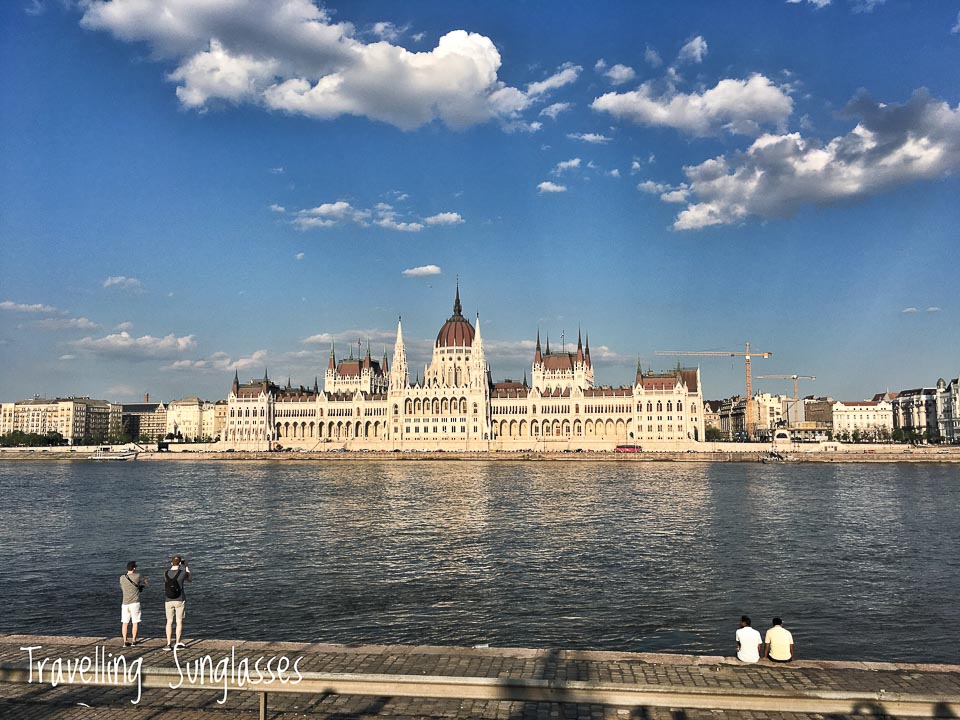
Among all Unesco World Heritage sites in Europe, Budapest certainly features plenty of historical and cultural attractions.
From Roman ruins to Art Nouveau buildings, strolling through the capital of Hungary feels like travelling in time. Even though the city was damaged during World War II, the reconstruction and restoration kept the authenticity and integrity of the urban architecture in a thoughtful way.
The Danube banks, Castle Hill, and Andrassy Avenue with Heroes Square are recognised as Unesco World Heritage areas.
Budapest city centre is built along the banks of the Danube river. On the East side of Pest, which was mostly developed during the 19th century, you will find incredible buildings such as the Hungarian Parliament, Saint Stephen Basilica, the Great Market Hall, the Dohany Synagogue, and the Hungarian Academy of Science. On the Buda side, instead, are located the Roman ruins of Aquincum, the impressive Statue of Liberty on top of Gellert Hill, and of course Castle Hill. The iconic Chain Bridge is obviously included, as well as the other downtown bridges.
Buda Castle Hill, instead, retained an Austrian, slightly medieval charm about it. The Royal Palace houses art galleries and museums, while Neo-Gothic Matthias Church and the Fishermen Bastion nearby are definitely one of the main attractions in Budapest.
Finally, Andrassy Avenue showcases magnificent 19th-century buildings, as well as the Opera House, which rivals the famous Vienna Opera House. The Avenue opens up to the majestic Heroes Square, a celebration of Hungarian history sided by two art museums. As if this wasn’t enough, the Millennium Underground Railway still runs underneath all this, the first metro in continental Europe.
Gammelstad Church Town, Sweden
By Karen from WorldWideWriter
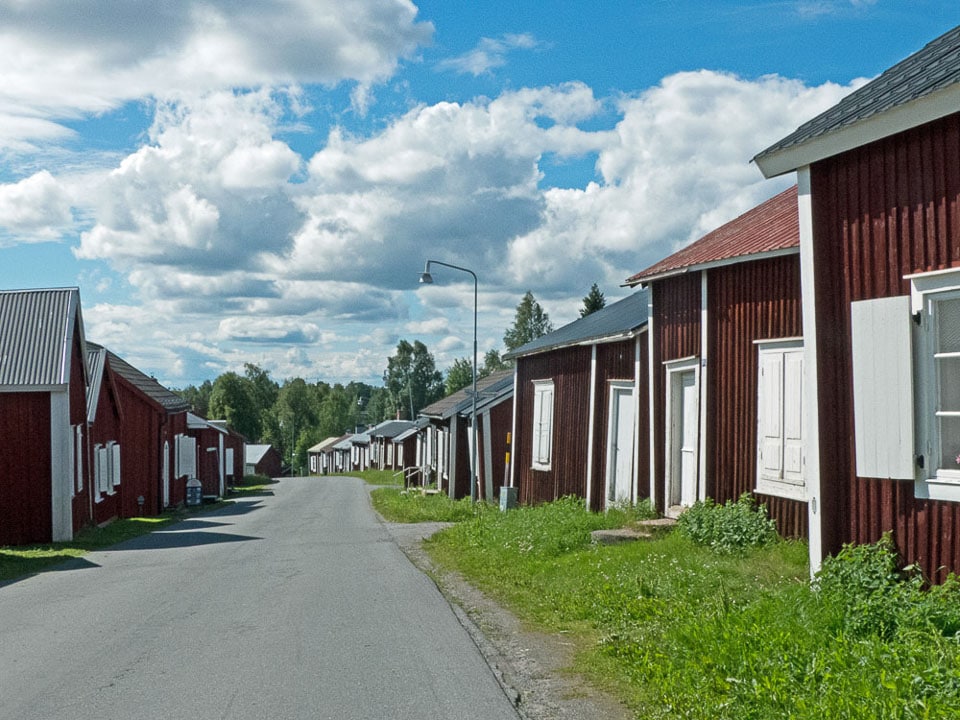
Gammelstad Church Town, near Luleå in the far north of Sweden, is not quite like anywhere else. The streets are lined with the red and white cottages that are so typical of Sweden, and there is a 15 th century church, but the town has never had any permanent residents.
This is one of Sweden’s church villages, built for the sole purpose of enabling people in remote areas to attend church.
In the middle ages church attendance was compulsory. However, in northern Scandinavia the population was widely scattered, and distances were too great for people to travel to and from the religious service in a single day. The solution was to build houses around the church where people could stay overnight. Over time, going to church evolved into an elaborate social ritual. For many people it was their only opportunity to meet their neighbours, conduct business, or even to find a marriage partner.
Remarkably, some of Gammelstad’s wooden houses are still used for church attendance today. Others are just places to escape to for a night or two, or for the owners to spend some time while joining with the social aspects of the town. But no-one is allowed to live here permanently, or to use their house as a holiday home.
Gammelstad Church Town became a UNESCO World Heritage Site in 1996. This was partly because it is the best remaining example of a church town in Scandinavia. And partly because it is a “living tradition”, a way of life that has continued for centuries.
Hallstatt, Salzkammergut in Austria
By from Martina and Jürgen from PlacesofJuma (@placesofjuma)
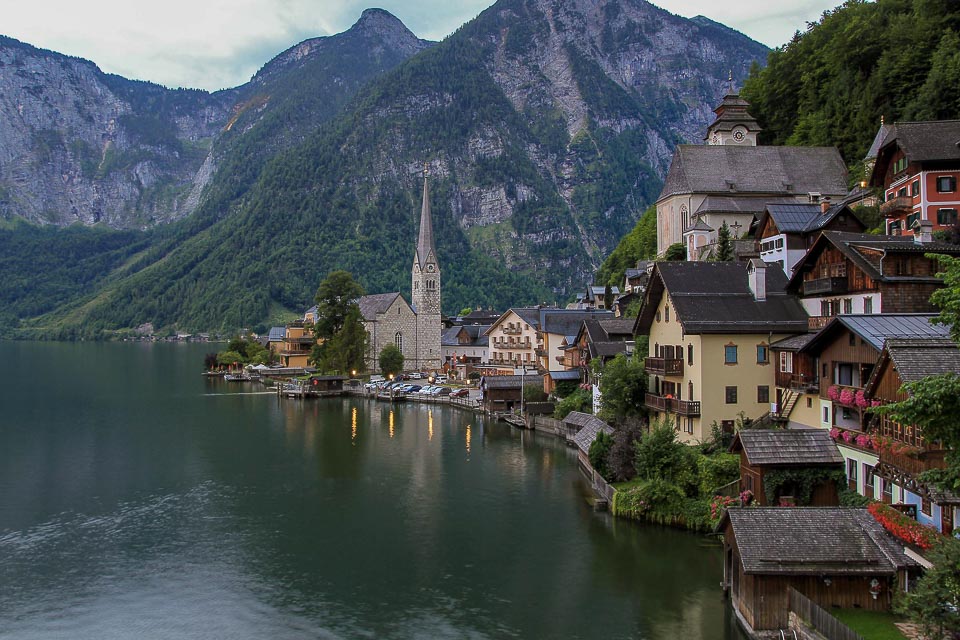
Hallstatt, the picturesque village at Salzkammergut, is definitely one of the most beautiful places in Austria. This village, with only 750 inhabitants, is nestled in pure nature between the mystical Lake Hallstatt and the huge Dachstein Mountains which gives a unique panorama.
The market municipality was already inhabited in the 1st millennium before Christ and since 1997 Hallstatt has been listed as an UNESCO world heritage site. Its prosperity since mediaeval times has been based on salt mining, focused on the town of Hallstatt, a name meaning salt settlement that testifies to its primary function. Nowadays the Hallstatt salt mines are open as a cultural attraction to public and can be explored by guided tours.
Exploring the old town with its beautiful old wooden 16th-century houses is one of the best things to do in Hallstatt. Behind every corner there is something lovely to see and with the gorgeous setting on Lake Hallstatt, it’s hard to believe that this place is even real. Although the village is relatively small, there are many cultural and historically important places to see, such as the old market square with the beautiful trinity column.
Also interesting is the ossuary in Hallstatt, where a collection of 600 brightly painted skull bones has been kept. If you love taking pictures, you should definitely visit the Hallstatt viewpoint, from where you will enjoy the most amazing old town view.
But also nature-lovers, sports and outdoor enthusiasts will enjoy their trip to Hallstatt area. The highlights here are hikes on the Dachstein-Krippenstein, a detour to the spectacular 5-finger skywalk and a visit to the Dachstein ice cave.
Graz, Austria
By Lina from World of Lina (instagram: @world.of.line)
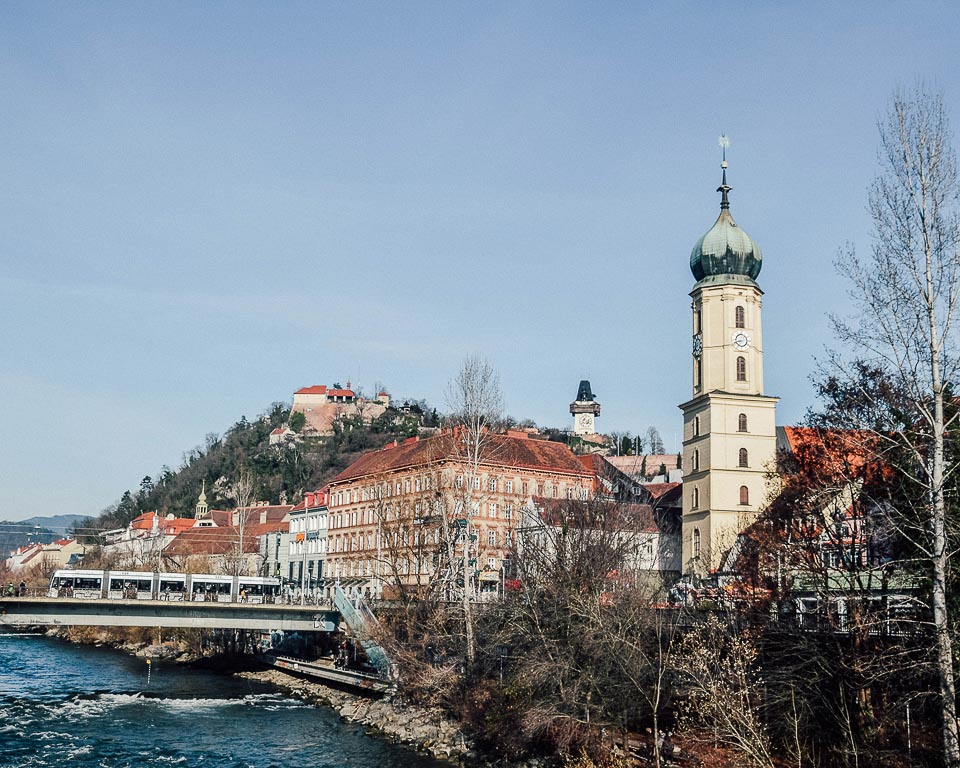
The three Austrian cities everyone knows are Vienna, Salzburg and Innsbruck. Barely anyone has ever heard of the Styrian capital Graz which is also listed as UNESCO WORLD HERITAGE site.
Despite being the second largest city in Austria, Graz has its very own provincial charm you won’t find in other bigger cities. Styrian people are also one of the friendliest folks in Austria and everyone is always super relaxed.
Of course, Graz offers many awesome things to see and do that no one should miss.
For example, there’s the sight of the city: a clock tower called “Uhrturm” overlooking the city on a small hilled named “Schlossberg”. You can either walk up there or take the rack railway. The view up there is just stunning!
Inside the “Schlossberg” there’s also the tallest underground slide in the world – a truly fun experience for young and old.
Another activity not to miss in the Styrian capital is a short visit to the “Kunsthaus”. This art museum features many different contemporary exhibitions and is a must for every art-lover. The locals living in Graz often call the building “Friendly Alien because of its unique and kind of weird-looking architecture.
Outside the city center you can find the beautiful Eggenberg Palace. It’s located in the middle of a big park with many lovely peacocks running around which makes it almost look like out of a fairy tale. It’s the perfect place for a walk and to get some fresh air. Especially in fall, it’s a mesmerizing sight with all the colorful trees.
If you want to enjoy a good cup of coffee, check out the places called “Gingko Greenhouse”, “Duck’s” and “il Café”.
Catherine Palace in Tsarskoye Selo, St Petersburg, Russia
By Anna de Nord from Travel Cultura
If we talk about UNESCO heritage in Russia, we have to mention St Petersburg and its multiple architectural and cultural treasures. One of the most popular UNESCO Heritage sites in St Petersburg is undoubtedly Catherine Palace in Tsarskoye Selo.
Catherine Palace is located in the suburb of St Petersburg, in the place called Tsarskoye Selo (Tsar’s Village). Nowadays, Tsarskoye Selo is a huge museum complex that includes multiple historical monuments: palaces, parks, pavilions, statues, etc. One day is not enough to see them all!
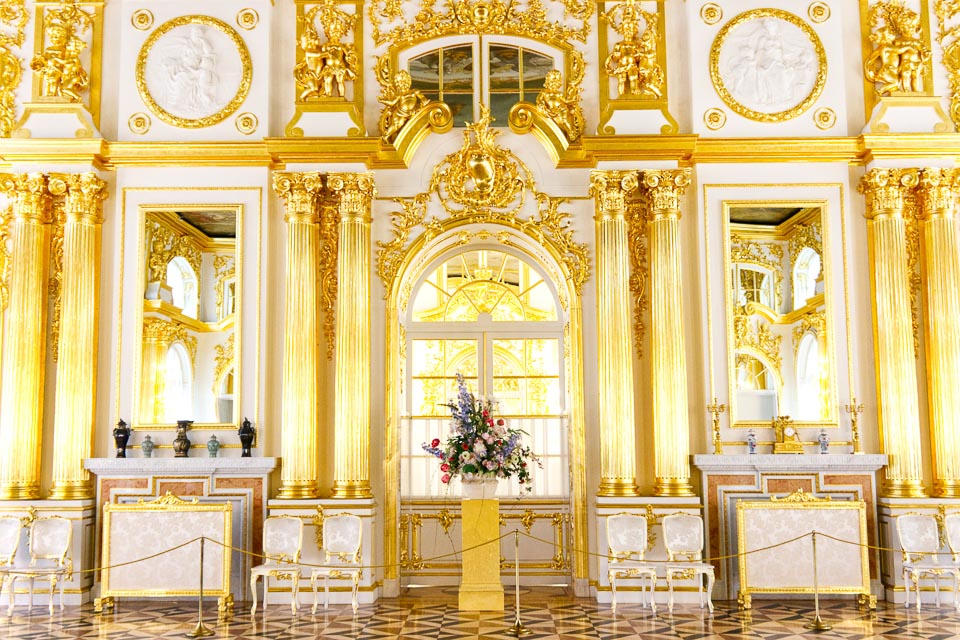
The gem of Tsarskoye Selo is Catherine Palace, the largest and the most magnificent building which impresses with the richness of the decoration of the facades. This palace is a former residence of Russian emperors. It was founded in 1717 by order of the Russian Empress Catherine I — this is where the name of the palace comes from.
Interiors of the palace are as splendid as its facades. I am sure you have heard about the legendary Amber Room — probably, the most famous room in the palace. Thousands of tourists come to Catherine palace every year just for seeing this wonder.
Surely, there are many other halls worth seeing, for instance, the Grand Hall richly decorated with gold and mirrors, the Picture Hall full of paintings, or the Lyons Hall with marvellous silk upholstery and painted ceiling.
If you plan to visit Tsarskoye Selo, go beyond Catherine Palace and explore the surrounding park. The Park can be considered as a museum under the open sky. Take pleasure to wander between marble statues and cosy pavilions, go around the pond and discover other hidden gems of Tsarskoye Selo.
Jvari Monastery (Georgia)
By Alex from Lost with Purpose (Follow her on IG @lostwithpurpose)
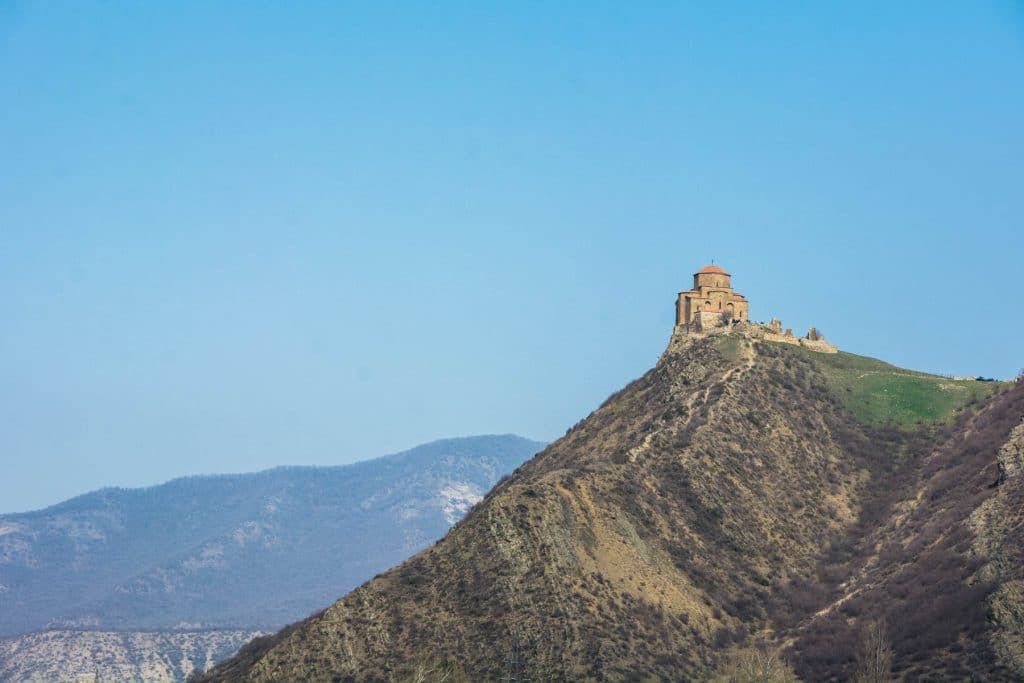
Sitting atop an epic mountain overlook—as most Georgian churches and monasteries do—Jvari Monastery is one of Georgia’s most iconic landmarks and one of its more accessible UNESCO sites.
Listed because it’s relatively unchanged since its 6th century construction, the hilltop monastery near the town of Mtskheta, Georgia overlooks the colorful convergence point of two rivers: the muddy Mtkvari and the aquamarine Aragvi. Mtskheta is one of Georgia’s oldest towns—established in the 5th century BCE—and though the Orthodox monastery is not quite as old, it’s just as significant. Jvari monastery’s age is a prominent reminder of Georgia’s historical claim as the world’s first Christian country.
The site first gained traction as a pilgrimage place in the 4th century, after Saint Nino planted a cross reputed to work miracles in the middle of what was once a pagan temple. Several centuries later, as pilgrims flocked in search of miracles, a cross-shaped church was constructed on the site. Despite its perilous position on the edge of a cliff, exposed to both natural elements and invaders throughout history, the monastery survived with minimal damage. Its architectural style, appropriately named Jvari, went on to influence churches later constructed in other parts of Georgia and neighboring Armenia.
These days, thanks to Jvari monastery’s close proximity to Tbilisi, Georgia’s capital, the medieval monastery is frequented by foreign and local tourists alike. Visit on a nice, sunny day and you’re just as likely to see rowdy crowds of Georgian wedding guests cheering on brides and grooms as you are other travelers!
Gelati Monastery, Georgia
By Emily of Wander Lush
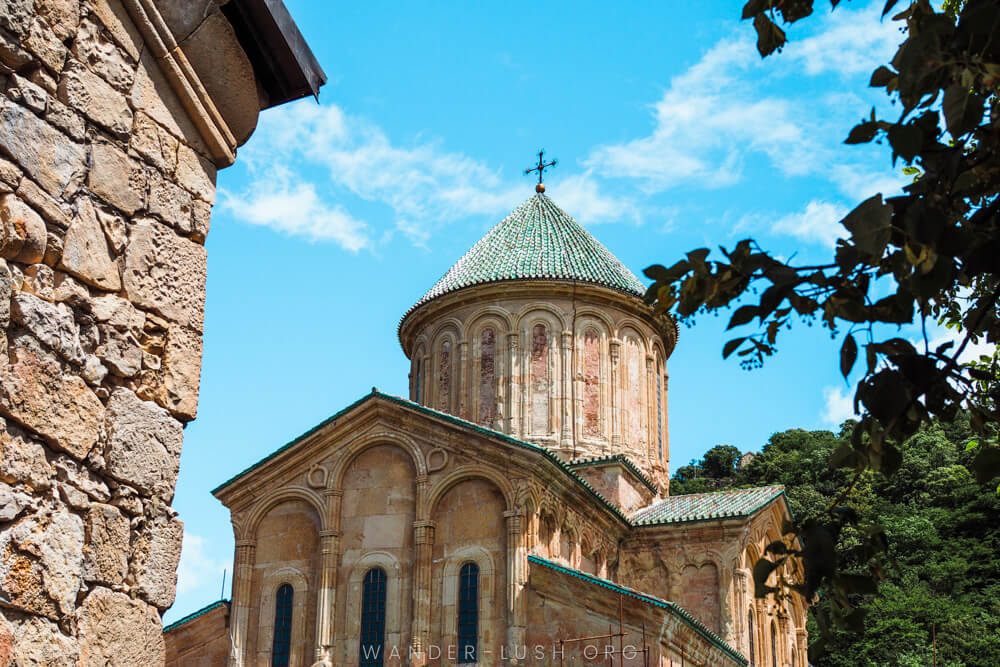
Gelati Monastery is one of three UNESCO World Heritage Sites in the Republic of Georgia. One of the best things to do when visiting Kutaisi, the country’s third-largest city, is to spend a morning hopping between the churches on its forested outskirts. Gelati lies 9km from the centre of town, just a short drive or pleasant hike away.
Gelati was inscribed by UNESCO in 1994 and is recognised for its architectural and artistic significance. Like most religious sites in Georgia, it has undergone many iterations over the years, but the original monastery building dates all the way back to 1106. Constructed during Georgia’s ‘Golden Age’, a short period of independence when the country reached its political and cultural peak, the monastery was an incredible feat of engineering for its time. Even today, it’s still one of the largest Orthodox monasteries in the country.
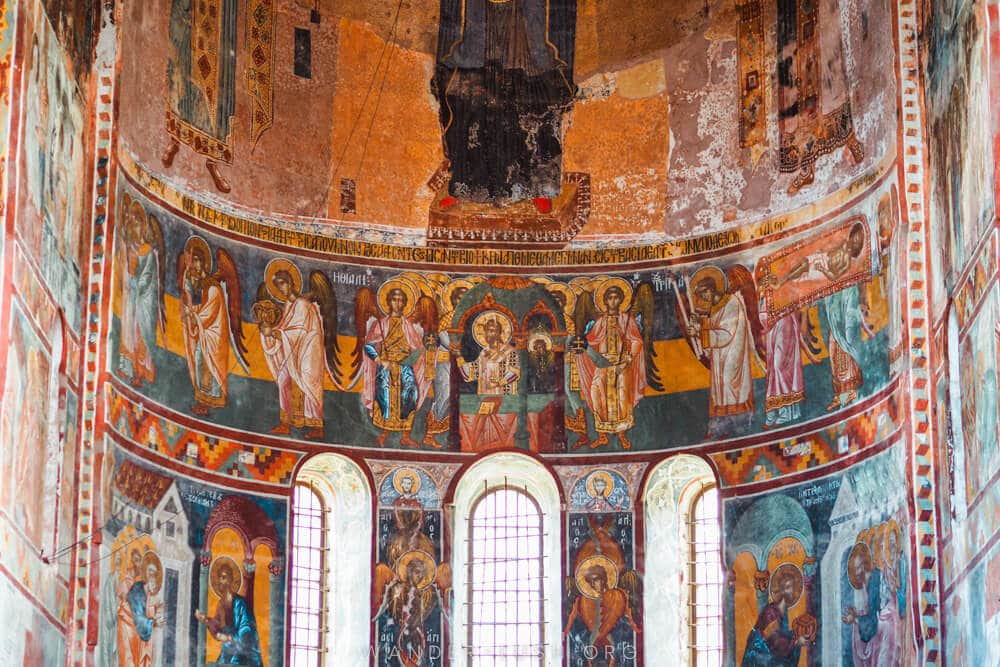
The Gelati complex consists of the main church, a monastery, and a series of buildings that used to house an academy. When it was functioning, Gelati was considered an important hub for arts and sciences and attracted intellectuals from across Europe. A specially built scriptorium, where monks copied out religious manuscripts, also existed on the site.
One of the main reasons Gelati is considered so important is because it’s the only medieval monument in the region that contains well-preserved Byzantine mosaics. The religious frescoes inside the church are also incredible, as is the building itself – an imposing sand-coloured stone structure topped with a distinctive green roof.
Skellig Michael, Ireland
By Emer and Nils from Let’s Go Ireland

Skellig Michael is simply amazing. If you want to explore a truly remote UNESCO World Heritage site (listed since 1996), then you need to travel to this little beautiful island off the west coast of County Kerry in Ireland. In order to get to the biggest of the two Skellig rocks, you need to take a 8 mile (12 km) long boat trip.
After you have landed on the island, you will have to climb about 600 steps. Once you have made it to the top, you will know that this trip was absolutely worth it. Not only is the location of Skellig Michael breathtaking, its cultural heritage is also just mesmerizing.
You can visit small beehive huts built by early Christian monks who lived on this remote rock from about the 6th to the 13th century. The monks believed Skellig Michael to be the edge of the world. You will understand why… Skellig Michael feels just so remote, serene and otherworldly.
That’s also why the Star Wars location scouts chose it as the location for Luke Skywalker’s exile in the recent Star Wars trilogy. Please note that the preservation of this special cultural heritage (in addition to it being a protected bird sanctuary too!) strictly limits the numbers of tourists to 180 per day in the summer months. So, make sure to book really early if you want to experience this once in a lifetime opportunity to explore one of the most unique UNESCO World Heritage sites on the planet. You will definitely not regret a visit!
Meteora, Greece
By Wendy Werneth from The Nomadic Vegan
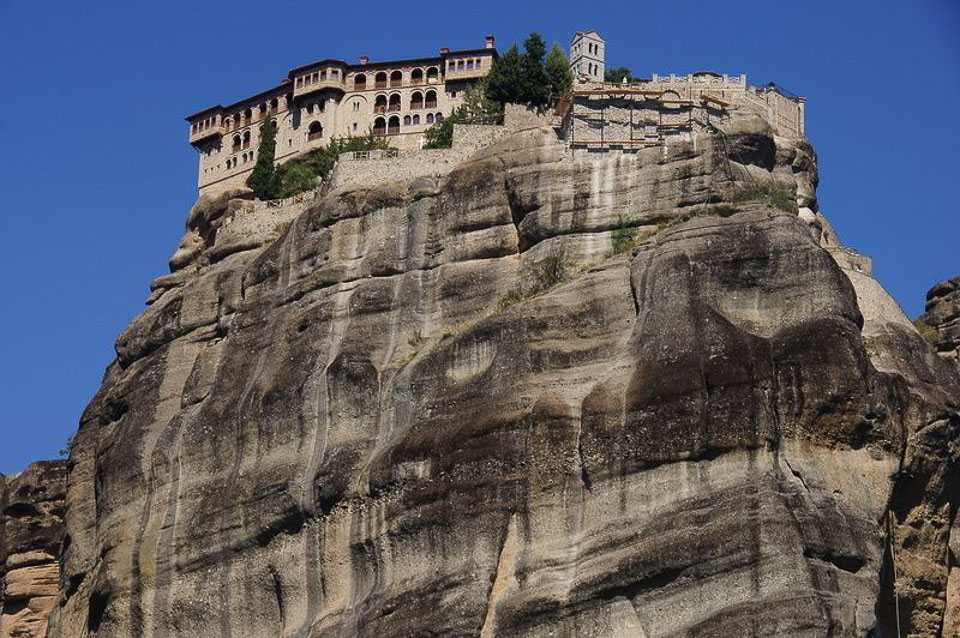
The word “meteora” can be roughly translated as “suspended in mid-air”, and the name couldn’t be more appropriate for this place. Set in a stunning landscape of towering limestone rock formations, Greek Orthodox monks built a number of monasteries here in seemingly impossible to reach places, high up on the top of these pinnacles. The reason they chose this unlikely location was not to make a stunning backdrop for your Instagram photos, but rather to avoid attacks by invading Turkish forces.
The earliest monks to arrive here lived as hermits inside caves, and you can still see a few rickety ladders leading up to these simple dwellings in the cliff face. Over the centuries, more elaborate monasteries were built. In total, there are 24 monasteries in Meteora, though you probably won’t have the energy to visit them all. Access is certainly easier than it was in the 14th century, when you had to either climb a series of wobbly ladders or be hoisted up in a basket, but there are still a lot of steps to climb to reach these cliff-top refuges.
Some of the best ones worth seeking out include Moni Varlaam, Moni Agias Varvaras Rousanou, and Moni Megalou Meteorou. The latter is the largest of the Meteora monasteries and features frescoes on the walls as well as a cellar full of wine barrels,
Take note that, to enter the monasteries, men must wear trousers that cover at least down to their knees, while women must wear full-length skirts (trousers are not acceptable for women). People of all sexes should also cover their shoulders.
Mostar, Bosnia
By Ellis Veen from Backpack Adventures
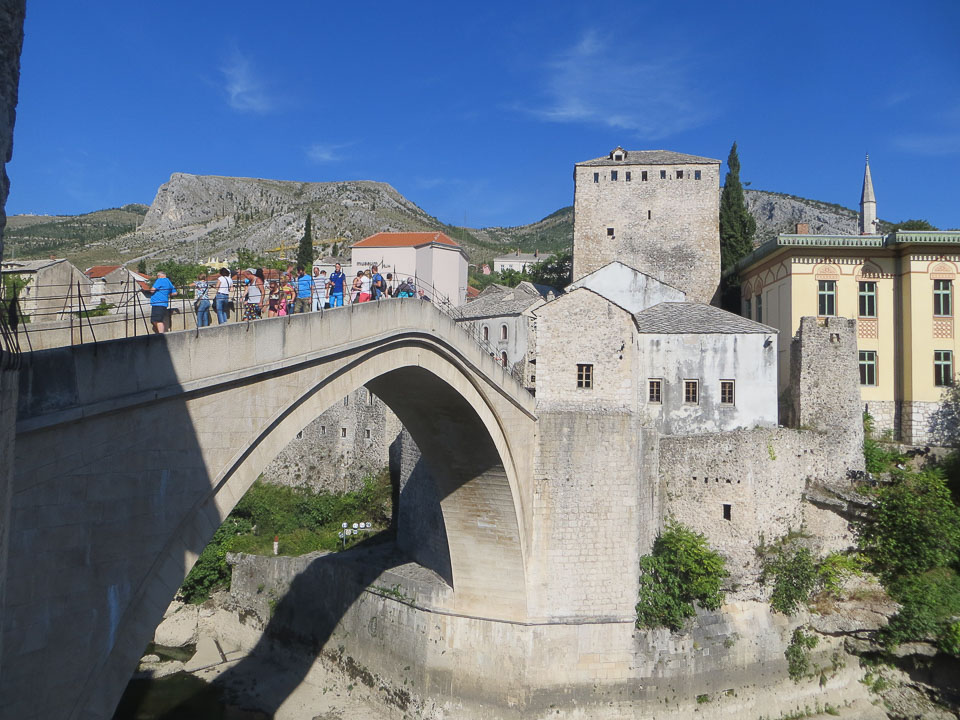
Mostar has a spectacular location in the southern mountains of Bosnia Herzegovina. The town has a long history and developed in the 15th century as an Ottoman frontier town. They build the historic center with its bazaar, fortification towers, turkish houses and the iconic bridge over the Neretva river.
It was the bridge that characterized this small town for centuries. Mostar, in fact, derives from the word mostari that translates as the bridge keepers. The bridge not only allowed traders to cross the Neretva river, but also connected the different residential neighbourhoods of the town.
Mostar has always been a multicultural town where jews, Bosniak muslims, Catholuc Croats and Ortodox serbs lived together in relative peace for centuries. Then in the nineties the Bosnian civil war broke out and much of the historic town was destroyed including the old bridge.
When the war was over it turned out that years of coexistence could not completely destroy the solidarity and cooperation of the different communities in Mostar. Soon there were plans to rebuild the bridge and historical center just the way it was using authentic materials and construction techniques.
Once more the old bridge is what defines Mostar and has become a symbol of hope and reconciliation. It is now also one of the most beautiful tourist attractions in Bosnia Herzegovina. Even though the old center is all renovated it has been done so well that its like traveling back in time to the Ottoman period.
Ribeira District – Porto, Portugal
By Ann Kelly from The Road is Life
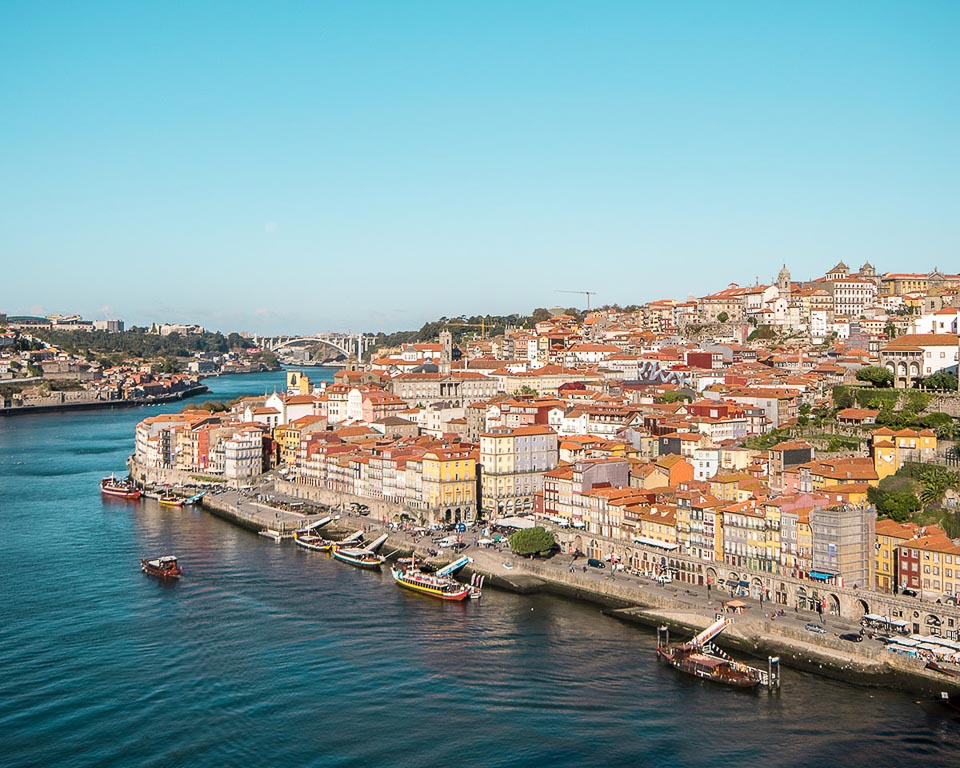
Located on the banks of the Douro River, the historic Ribeira District is the heart of Porto and also the city’s oldest neighborhood. The colourful buildings that line the waterfront date back to the 14th century and it was listed as a UNESCO World Heritage site in 1996. Historically, the Ribeira District was once the centre of the city’s river trade and a busy hub for boats coming in from up and down the Douro River.
Nowadays, the Ribeira District is a bustling hot spot of Porto attracting tourists and locals to dine at the many riverfront bars and restaurants. It’s the perfect spot to grab a glass of Port wine and take in your surroundings, it really comes to life in the evenings. Take a wander through the narrow, winding alleys extending inland from the riverfront, this is the best way to stumble upon the most authentic little Portuguese restaurants.
Make sure to stop at the “Praça da Ribeira” or Riberia Square, there plenty of bars and restaurants to choose from and beautiful medieval buildings to admire. For the best view of the Ribeira District, you can cross the Dom Luís I Bridge and get a breathtaking view from above, or continue across the bridge for another stunning angle looking across the Douro River. The Ribeira District is rich in history and culture and if you plan to spend a few days in Porto, it is definitely the best location to base yourself!
Cordoba, Spain
By Paulina from Paulina on the Road (Follow her on IG @paulina_on_the_road)
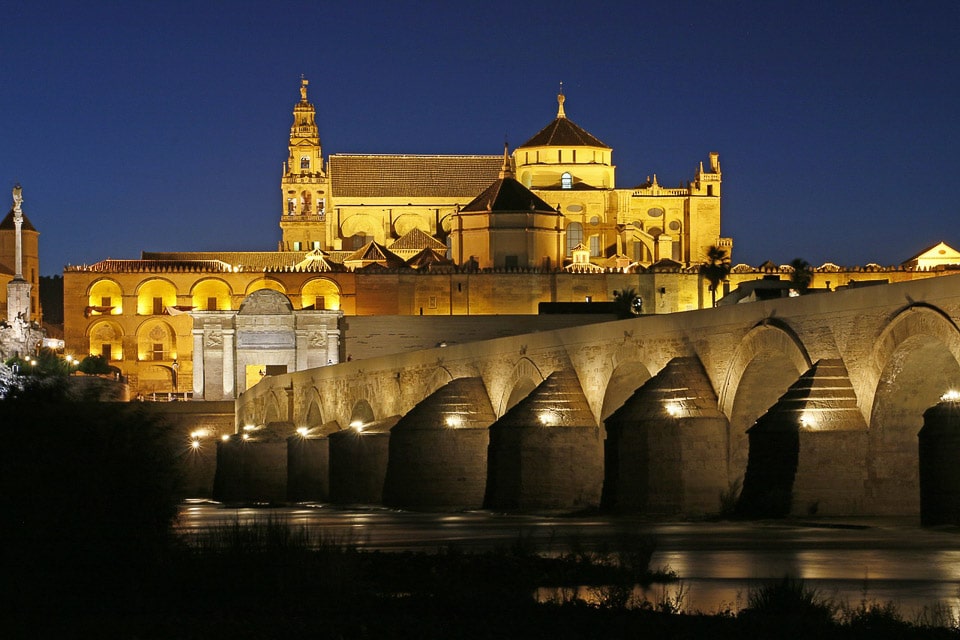
If you are looking for unique UNESCO world heritage sites in Europe, you cannot skip Cordoba and its mosque. Indeed the entire historic city center of Corboda is considered UNESCO World Heritage since 1984.
What are the things to see here? Of course, the Mezquita, with its signature striped arches, and the Juderia has windy streets; look out for the beautiful patios, for which Cordoba is known. The Alcazar has beautiful Moorish-style gardens, with large pools and fountains and stunning flowerbeds. They are a must of any Cordoba itinerary and are considered one of the best things to do in Cordoba.
The highlight is without any doubt the Cordoba Mosque. Built between 784 and 786 as a mosque, it was established as a cathedral when the Christians conquered the city. It was Cordoba’s first UNESCO World Heritage site. The city center and Alcazar were included lateron. The impressive, vast structure, is the perfect example of Moorish architecture and a stunning cathedral at the same time.
Las Fallas in Valencia, Spain
By Lauren Cirkot from Always Find Adventure (Follow her on IG: @laurencirkot )

Valencia, Spain is home to the Fallas Festival, a traditional celebration held every March to mark the arrival of spring. The festival traces its origins to the 18th century and is a source of community pride and cultural identity for Valencians. There is so much to do and see during Las Fallas: parades and paellas in the streets, music, and, of course, the fallas themselves. Meaning “failures,” the fallas are large structures made of wood and Paper-mâché, created by artists and erected throughout the city to caricature Spanish politicians and celebrities and comment satirically on current social issues.
The fallas can be up to 40 feet tall, and the artists work on them all year long. On March 19 (St. Joseph’s Day), these structures are burned to signify the coming of spring and the purification and rejuvenation of communal social activity.
There are more than 350 fallas communities throughout the region. These communities break out into camps on the streets, so that everywhere you turn, you’ll see an array of locals in traditional costumes playing music and cooking paella. One representative is chosen from these communities to be the Queen of the Falla. She becomes the face of the festival and presides over all the major events.
From March 15-19, all day and night, the city of Valencia is one big street party. Your senses will be moved by fireworks, traditional dress, nightlife, food, concerts, and more. This is a world-famous event that is not to be missed!
Stonehenge, United Kingdom
By Jenna Rank from I know the Pilot (Follow her on IG: @iknowthepilotau)
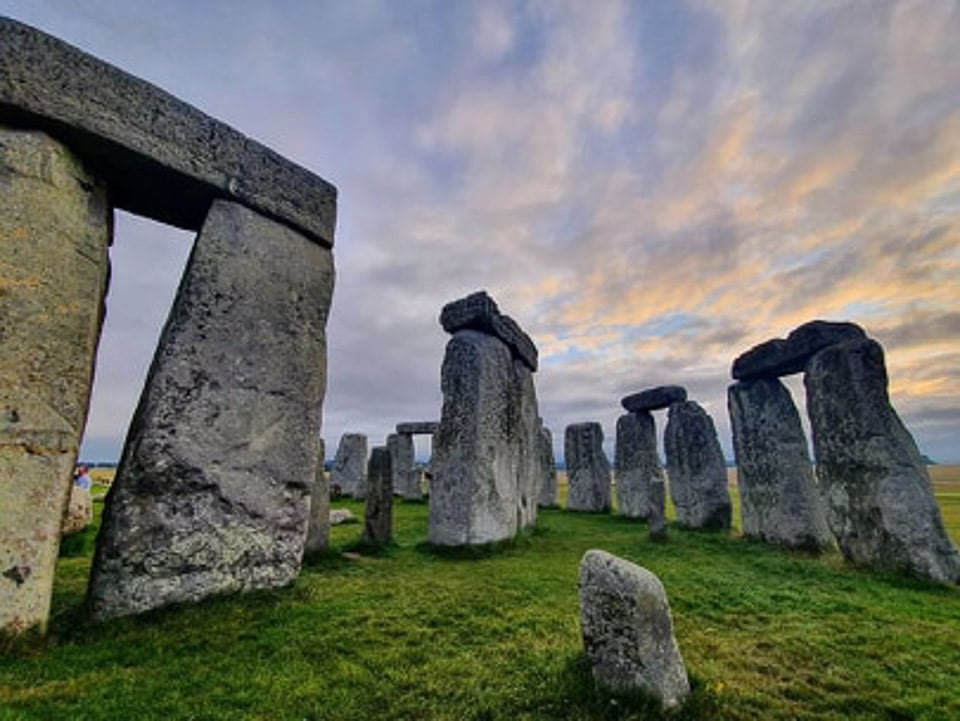
Stonehenge is one of the most iconic sites in Europe, if not the world. With it’s instantly recognizable silhouette, this prehistoric English landmark draws almost a million visitors a year to it’s position on the Wiltshire Plains. Believed to have been built close to 5000 years ago, Stonehenge continues to inspire wonder and debate to this day. Many mysteries still surround the site, and researchers are still not completely clear about the full function and purpose of Stonehenge, which only adds to its allure.
It is believed that the primary use of the site was in some way spiritual or ceremonial, and fragments of bone have been found through excavations, as well as burial mounds nearby. Comprised of an earthen bank and ditch, as well as the famous ring of standing stones, researchers have discovered that the stones themselves came from as far away as Wales (roughly 180 miles)!
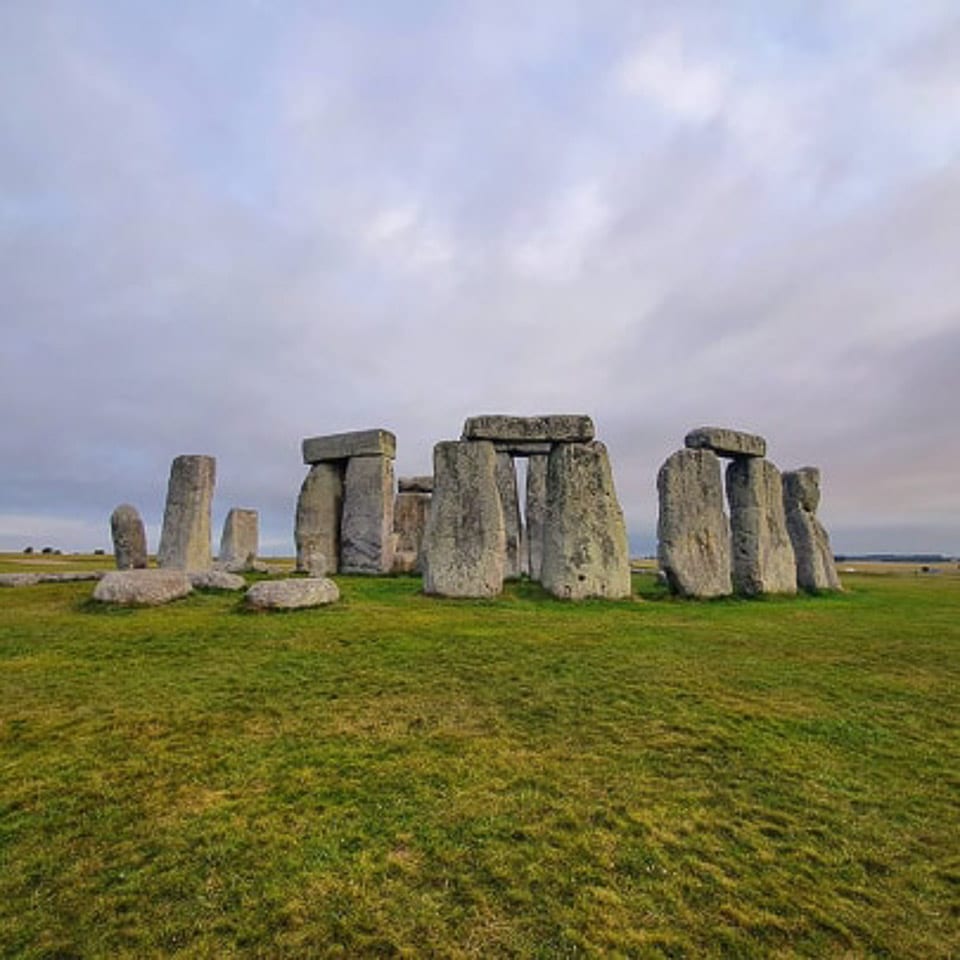
In the current day, Stonehenge is widely seen as a cultural icon of England, and was one of the first ever sites to be legally protected as a Scheduled Ancient Monument in 1882. It was added to the UNESCO list of World Heritage Sites in 1986. The site has provided many important clues about Neolithic and Bronze Age settlers, adding to the rich tapestry that is England’s past, and allowing all of us a better understanding of our collective history. Many visit this site as a day trip from London, and there are several tour companies that include a visit to Stonehenge on their itineraries.It is also easy to visit with a car.
However, the surrounding area is also definitely worth a look, so if you can, spend a night or two in nearby Salisbury (worth a trip in itself). The current Stonehenge site is located in a large field, and comprises a museum, an outdoor ‘Neolithic Houses’ exhibit, shop and a cafe, as well as the stones themselves. A short bus ride is necessary to get between the Visitors Centre and the stones.
Visitors cannot physically access the stones and must stay behind a barrier that runs around the perimeter. This is to protect the stones and maintain the site, and means nobody gets in your photos! However, there is a way to get up close and personal with Stonehenge (for a fee, of course). If you request a ‘Stone Circle Experience’ visit, you may be allowed into the site early (and we mean early) and have direct access to the site. Visitors still aren’t allowed to touch the stones, but seeing this monument so close (and with no crowds) is a truly special experience. You can request your visit here and someone from English Heritage will get in touch with you.
Stonehenge is a truly unique site, and one that we are lucky to be able to experience to this day. A tribute to the vast and varied history of England, we can only imagine what these stones have witnessed throughout the years. Don’t miss a visit to this incredible place on your next Europe trip!
Valdobbiadene and Conegliano in Veneto, Italy
By Molly Fitzpatrick of Luggage and Life
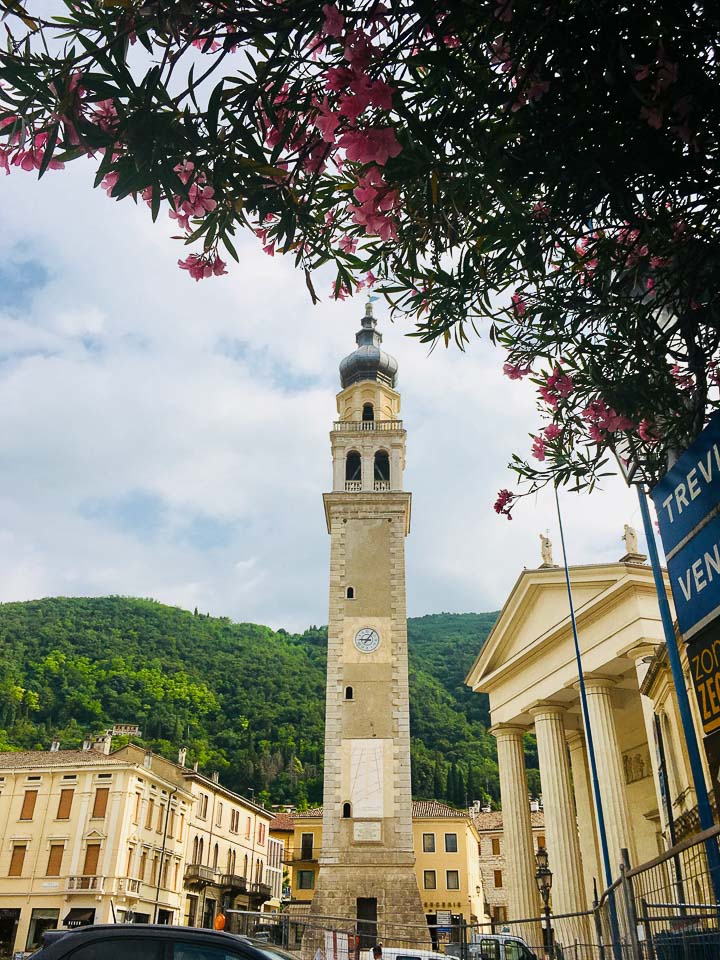
In 2019, the prosecco hills in the Veneto region of Italy became the country’s 55th UNESCO World Heritage Site. Classified as a cultural landscape, the hills were included in this category because they represent the evolutionary interaction between people and nature. Owing to their rugged topographical features, the prosecco hills present various challenges to cultivation.
These challenges have been overcome for centuries with the creation of specific practices and techniques that have given the area its characteristic checkerboard appearance. The first of these are the terraces known as ciglioni, which are used to provide a surface area for growing vines. The second is a vine-training technique known as bellussera. Designed in the late 1880s, it contributes to the unique aesthetic appearance of the area.
Small patches of forest, trees, hedges and even villages dot the landscape between, above and below the vineyards, which produce the small, plump, green Glera grapes that are turned into the world-famous sparkling white wine, prosecco superiore. Over the years, the hills have survived pests, wars, and industrialization, and the area and its practices remain well-preserved. Increased pressure has fallen on the vineyards recently, due to a high global demand for prosecco (in addition to it being used to make spritz at every bar in Venice and its environs).
Fortunately, the land and its traditions are protected not only by UNESCO, but also by Italy’s DOCG consortium (Denominazione di Origine Controllata e Garantita), which ensures that the vineyards are maintained and that the local traditions, biodiversity and ecosystems are preserved as well. The region can be visited on La Strada del Prosecco, a road that leads from Conegliano to Valdobbiadene and offers sweeping views, visits to churches, castles and other historic sites, and of course, stops at many vineyards along the way.
Matera, Italy
By Merryl from Merryls travel and tricks (Read her posts on Puglia, Italy here)
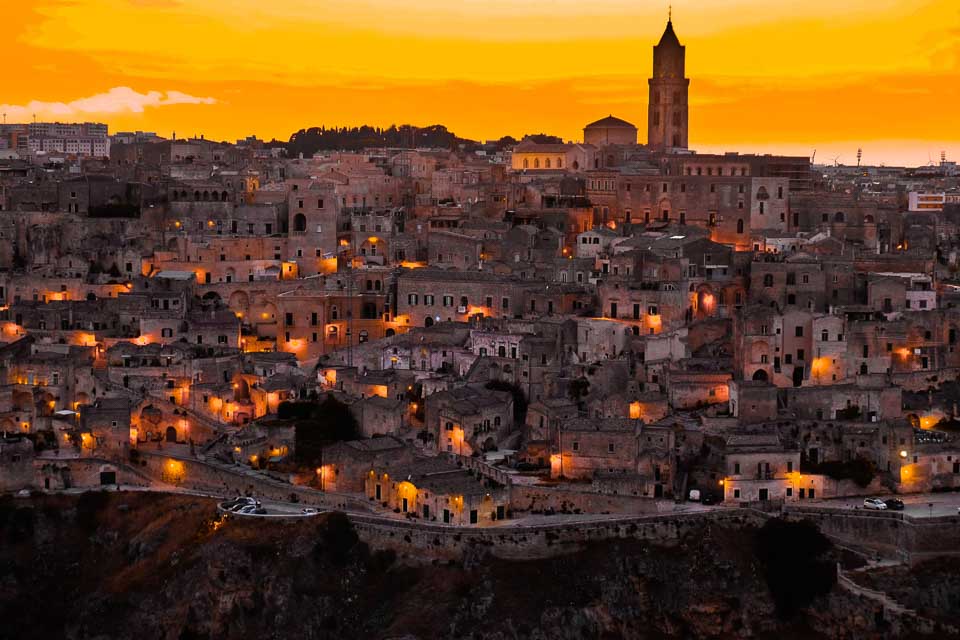
Matera is one of the most unique town in all of Italy. It is one of the oldest continuously inhabited cities in the world since the Palaeolithic period. The entire ancient city center of Matera is carved into the rocks found in the region. Hence it is known as the city of the Sassi which is the Italian term for stones. Additionally, this UNESCO site was declared as the European Capital of Culture for 2019.
The ancient city center of Matera even today is well preserved and inhabited by the locals. Most of the caves in the Sassi of Matera today are converted into small shops, restaurants and hotels owing to the increase in tourism.
What is fascinating though is the architecture of the Sassi of Matera. The style used is unrepeatable as it portrays man’s ability to perfectly adapts to the changing environment conditions through the years. The houses built inside the cave helped to keep the temperatures inside constant through the year and the slopes were used to ensure that the water would flow right through during heavy downpours. They also had a hidden architectural structure consisting of tunnels, caves, cisterns and water control systems that were essential for community life.
Today, this ancient city has a lot to offer from churches to piazzas and palaces. You can find cave restaurants in the Sassi of Matera where you can enjoy a meal inside these ancient structures. Make sure to try the peperoni cruschi, a local dried and fried pepper snack that is absolutely addictive.
The Valley of the Temples in Sicily, Italy
By Marjut from The Smooth Escape
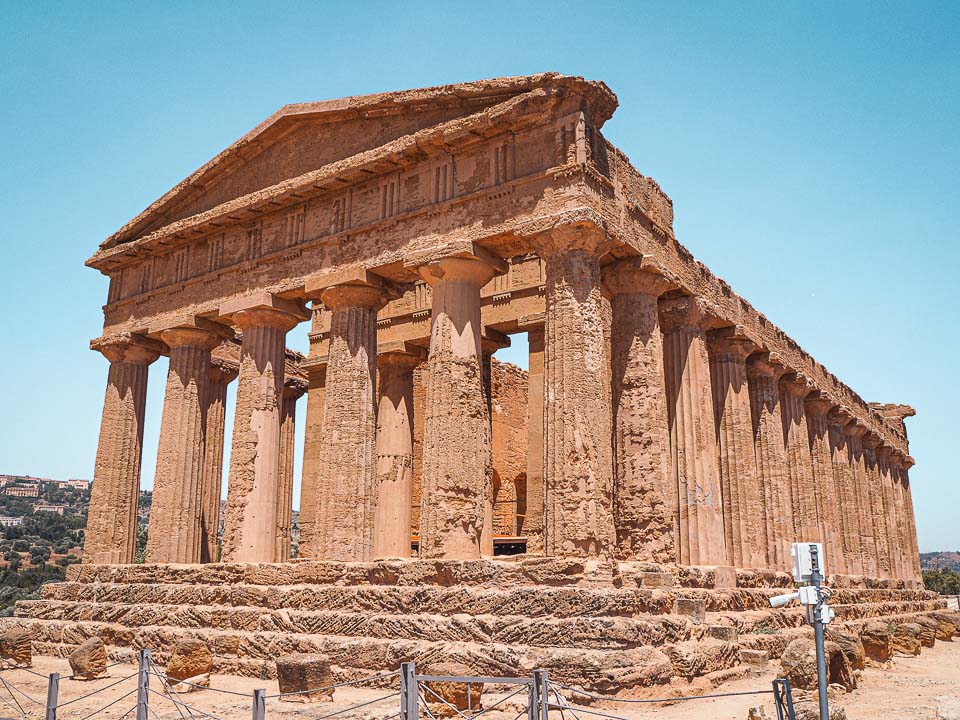
The island of Sicily is home to a truly impressive archaeological treasure – the Valley of the Temples. Located near the town of Agrigento on Sicily’s southern coast, the Valley is one of the main attractions of the island and covers the area where the ancient Greek town Akragas used to lie.
With the remains of seven fascinating temples, this UNESCO World Heritage Site is considered one of the most outstanding examples of Greek architecture in the world. The most impressive and best-preserved structure in the park is the Temple of Concordia which was built 440 BC and boasts a remarkably intact facade with giant columns. Some of the other must-sees in the Valley include the Temple of Heracles, Temple of Juno and the bronze statue of fallen Icarus, which is actually a modern interpretation of the classical style and not an ancient sculpture.
In the Valley, you’ll also find the ancient Kolymbethra Garden where the residents of Akragas used to cultivate fruit and vegetables, and where they constructed a network of tunnels to supply their city with water. Dotted with fragrant citrus trees, almond trees, olive trees, and cacti, this beautiful oasis offers a lovely shaded spot to relax after visiting the awe-inspiring temples.
As the site spans over 1,300 hectares, I recommend setting aside at least three hours to explore the most exciting attractions and get a feel for the place. If you plan to visit the Valley in the summer months, remember to bring some water, sunscreen and a hat as you’ll be wandering around for hours with almost no shade from the sun.
Bryggen, Bergen
By Imani Adeyemo from Imani Escapes
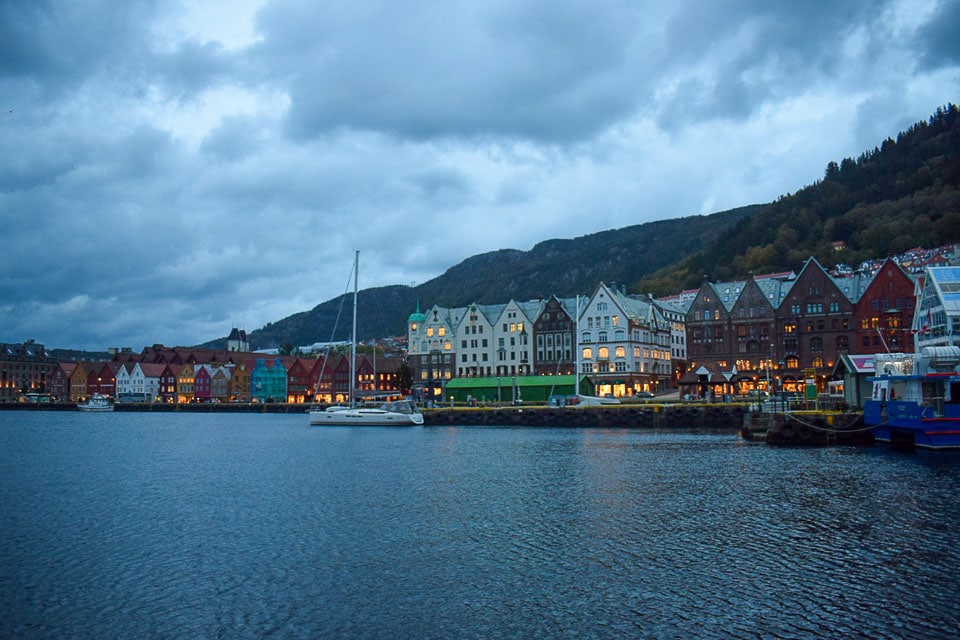
Bergen is a city in Norway located nearby fjords, mountains and glaciers, that can be reached directly by plane or via a scenic 7 hour train from Oslo. It is a favourite of people looking for adventure holidays and those who want to explore the famed fjords of Norway.
One of the main tourist attractions in Bergen is Bryggen, the old town which is comprised of several colourful, old houses by the waterfront. They date back to the 14th century and made up a harbour district, which was the centre of trade in the city. You can walk around Bryggen today, and visit the Hanseatic Museum to tour the interior of some of these buildings and learn about their history. You can also visit the Bryggen museum, which was built on the site of one of the fires, to view artefacts from the ancient Bergen.
Due to their largely wooden design, the houses of Bryggen have been affected by multiple fires throughout history, including in the most notable one in the 1700s, and have been reconstructed several times. A lot of the refurbished building fronts now house shops. The reconstructions have followed the traditional style of building and materials used. The buildings themselves are narrow and three storeys tall, built in rows with narrow passageways between them.
As well as being a site of historical and cultural interest, Bryggen is Bergen’s most recognisable landmark and a very pretty architectural feature of the city.
Also Read: Most Scenic Train Journeys of Europe!
Sibiu, Romania
By Sean Lau from LivingOutLau
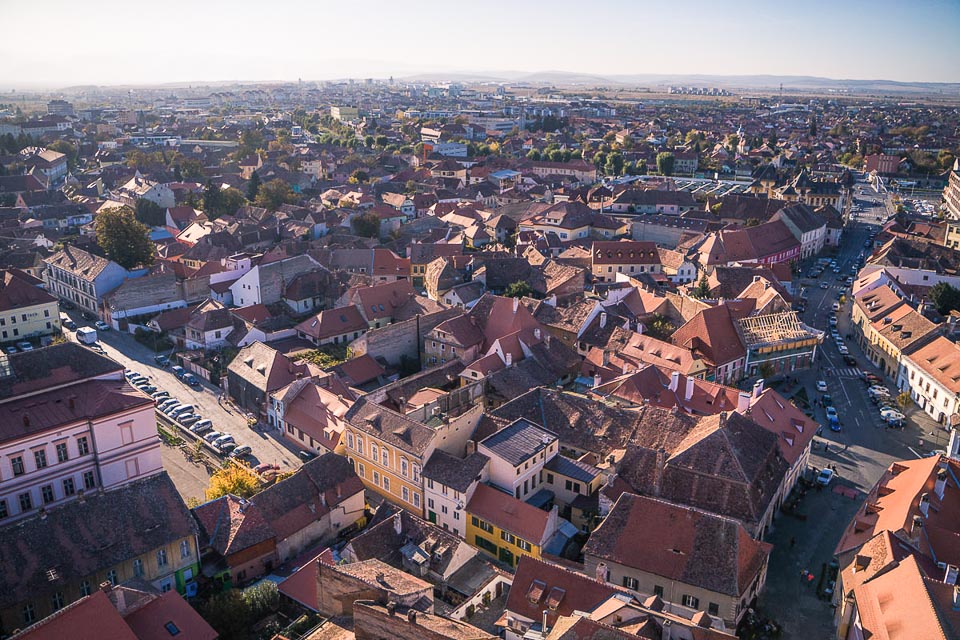
Romania, one of the lesser-visited countries in Europe, is mostly known for the Dracula legend and the famous Bran Castle. Many visitors aren’t aware of the other wonderful places in Romania, such as the UNESCO Heritage Site of Sibiu. A small city located in the region of Transylvania, it is surprising that it has such a big historic significance, so much that it was named European Capital of Culture for the year 2007.
Originally founded by the Transylvanian Saxons (Germans) in the 12 century, it quickly became the most wealthy and influential town in the region. Shortly, Sibiu became the capital of the Transylvanian Saxons. It was not only the most wealthy town in the region, but also the administrative and religious center at the time. With so much wealth, the Saxons built the most impressive buildings and fortifications needed to protect them, many of which can still be seen today.
The most famous of which is the Big Square, a huge open-space area where merchants can sell and trade their products. Nowadays, it has become one of the most popular places in Sibiu to hang out and meet friends. Another popular spot in Sibiu is the famous Passage Of Stairs. Its original use was only to connect the Lower Town and Upper Town. Nowadays, it is one of the most picturesque locations in Romania and something you cannot miss when you visit Sibiu. At one end of the passage stands The Golden Barrel, one of the oldest restaurants in Romania worth trying!
Telč, Czech Republic
By Adriana Plotzerová from Czech the World
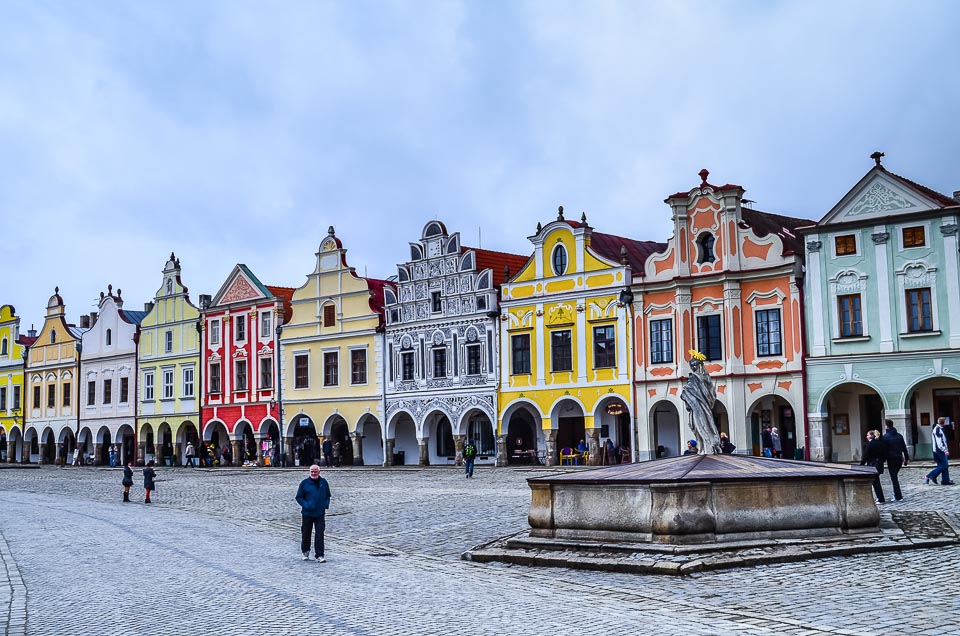
Telč is a small fairytale-like town surrounded by ponds, fields, and forests in Vysočina Region. It’s an ideal destination for everyone who wants to escape the rush and ejoy the countryside. Telč’s main square is one of the most romantic places to visit in the Czech Republic. Imagine colorful historic houses with high gables and arcades build in a Renaissance and Baroque style where you can find lovely cafes, galleries or little shops. Building facades are characterized by a diversity of decorative elements. In the middle of the triangular market square, there is a fountain and a plague column. Telč’s historical center is rightly part of the UNESCO World Heritage site.
Don’t forget to visit the 17th-century chateau with an English-style park, one of the gems of Moravian Renaissance architecture. The original Gothic castle was rebuilt by Zachariáš of Hradec in 1533 and it‘s inspired by the Italian Renaissance style. Not only the Chateau‘s façade is decorated with beautiful sgraffito, but you can find sgraffito decoration even on other houses in the town. Telč has also city walls built of stone, originally built for its strategic security.
Besides the romantic walks around the historical center, visits to little shops and cafes in arcades, Telč offers also many other activities like horse riding, cycling, swimming, bowling, rope-courses, sport fishing, technical museum, reconstructed Telč underground, steam mill, and many others. You can also visit nearby castles of Roštejn, Štamberk, and Landštejn or lookout tower Oslednice.
Telč is a perfect destination for every history, and culture lover.
Liverpool Maritime Mercantile City, England
By Pauline Vergnet from Bee loved City
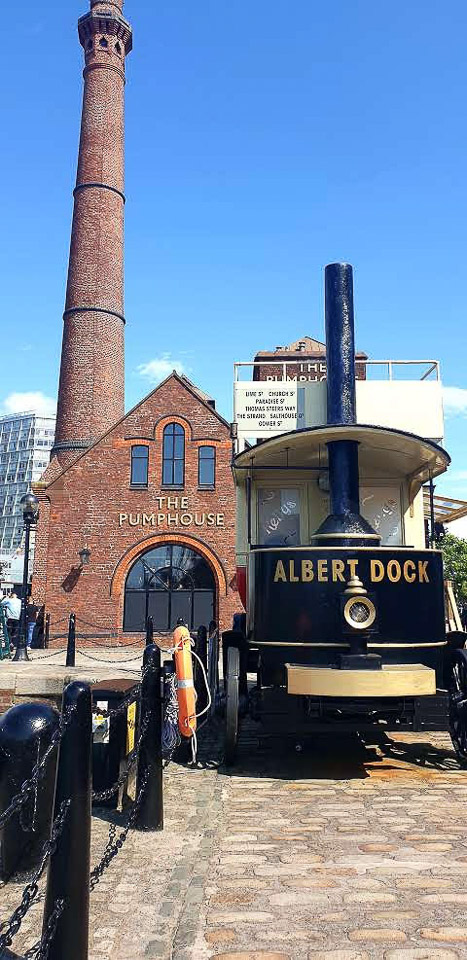
When it comes to UNESCO sites in Europe, it would be impossible not to mention Liverpool in England.
Liverpool is mainly known for being the birthplace of the Beatles and British Rock music but there is so much more to know about this incredible city!
Liverpool played a major part during the triangular trade (18th century). It was the main port of entry to Europe and quickly grew to become the biggest harbour in Europe. Almost all products coming from the Americas would go through Liverpool. If you walk around in the city centre, you will notice pineapples on some buildings. These golden pineapples were a sign of wealthiness. In fact, the first pineapples and tomatoes to arrive in Europe came through Liverpool. It was a very wealthy city back then and got to try all these new american products first.
Speaking of the world’s firsts, Liverpool harbour was also the first one to use wet docks. This technical method was a real revolution for the maritime sector as it allowed a quicker turnaround. This means that instead of having to wait days while the tides would go in and out, Liverpool harbour could work 24/7!
Nowadays, you can visit Liverpool Maritime Mercantile City. Just head to Albert docks. You will find loads of great cafes, restaurants and museums!
If you are interested in British history and more specifically the British colonial empire, Liverpool is the place for you!
Holašovice, Czechia
By Martha from Quirky Globetrotter

When you think of bright, colorful architecture with crisp, smooth lines, Spanish-style buildings erect in your mind. Though, baroque architecture is one architectural style that I would argue is able to compete. Savor a full taste of impeccable baroque architecture in the small village of Holašovice in Czechia’s South Bohemian countryside.
Holašovice, a UNESCO World Heritage site, is a small quaint village that has preserved the history and beauty of baroque-style architecture. During your stay ask for a local to show you around the town to give you the inside scoop on how this style shapes the local’s daily lives. You’ll explore Czechia farmsteads with horse barns and intricate water trough systems. Since Czechia has a rich agricultural background and history, this quick stopover is a great way to get a full encompassing view of the country and its culture.
Taking a tour through Holašovice taught me to slow down and try to decipher the story that architecture paints for us. Architecture is often considered to only be a representation of beauty. Yet, walking around with a local they pointed out the cultural significance of even the smallest. For instead, one homestead had a rickety archway build of small branches and boughs. Ribbon was carefully intertwined within the branches and held small springs of dried flowers in place. This was a wedding arch that the town decorated for the newlyweds to celebrate a new beginning blossoming. To me, an ordinary pedestrian, I would not have understood the cultural significance a homemade arch holds in this community.
Don’t forget to snap a few photos at the picturesque fishing pond in the center of town. You might get lucky like me and be able to engage in a cultural tradition with the locals by taking two traditional shots (“one for each leg”) of Silvovice, a fruit-infused brandy.
Rocamadour, France
By Lucile from Lucilehr
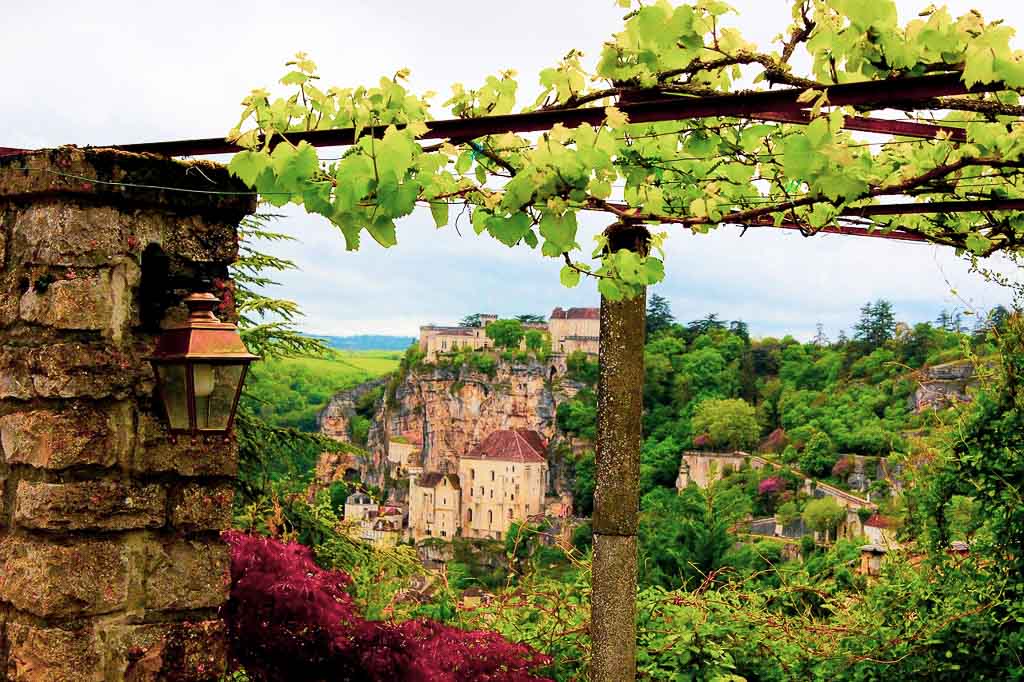
The breathtaking clifftop village in Rocamadour welcomes millions of visitors each year. In fact, it is one of the most popular tourist attractions in France, coming only second to Mont-Saint-Michel. But why is Rocamadour so popular?
Also a UNESCO World Heritage site, Rocamadour is known as a pilgrimage destination. Located 100 miles north of Toulouse, the site is frequented by tourists and pilgrims alike for its fascinating history, religious interest, magnificent architecture, and the picturesque views it offers – considering the village is located on top of a rocky plateau, providing an overlooking of the Alzou Valley.
To get to the heart of Rocamadour, you have to climb 216 steps first. Some pilgrims, as an act of penance, would climb on their knees – and they’ve been doing so for hundreds of years. According to history, in 1166, a perfectly preserved body was found under the Chapel of the Virgin and was placed near the altar. Since then, miracles reportedly started happening. People believed that the body belonged to a hermit named St. Amadour.
In the lower part of the village, you’ll feel a sense of peace just as you walk along the quaint little streets. Little shops also lined the streets and if you fancy delicious food, you can stop by in one of the many cafes. And of course, during your trip to Rocamadour, don’t forget to sample the village specialty- the Rocamadour cheese.
Cheese lovers out there will be delighted to have a taste of this wonderful cheese made from unpasteurized whole goat’s milk. It’s simply an irresistible treat that you wouldn’t want to pass up. If you happen to visit in June, you’ll be in luck as the village will host a cheese festival, which is a celebration of the different local cheeses.
Also read: 10 Old Styles of of European Clothing!
Kronborg Castle, Copenhagen, Denmark
By Derek from Everything Copenhagen
One of the best things to do in Copenhagen is plan a day trip to explore the sites outside of the Danish capital. There is a quaint city about 40 minutes north of Copenhagen’s city center that has a very famous castle. That castle once played an important role in Denmark’s control of trade in the Baltic Sea, but you may recognize it from a different historical reference – William Shakespeare.
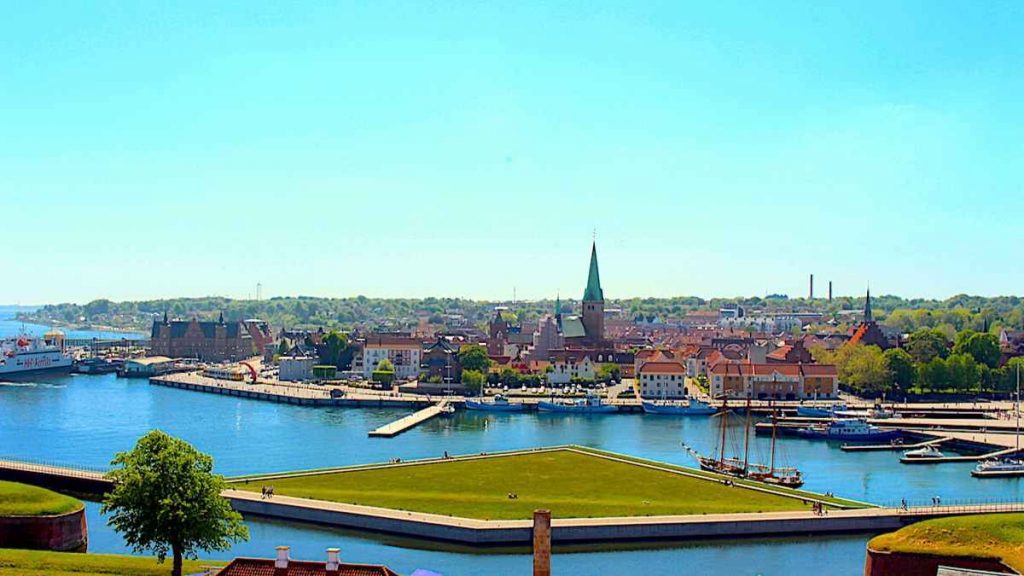
There’s something rotten in Denmark is one of the famous lines from Shakespeare’s tragedy, Hamlet. The setting of the play is of course in Denmark, but more specifically it’s at Kronborg Castle in the charming Danish town of Helsingør. The literary fame and historical military and commercial importance of the site has earned Kronborg Castle the distinction of a UNESCO World Heritage site.
Visitors to Kronborg can see first-hand where the scenes of Hamlet were inspired, and guides will tell you that acting troupes from London performed in the castle during Shakespeare’s era. It’s likely that he would have heard about the Danish castle or even performed for the court of Danish royalty himself. Although that history is unknown, you can visit the same great hall where the tragedy took place and even enjoy Shakespearean actors performing scenes during the summer months.
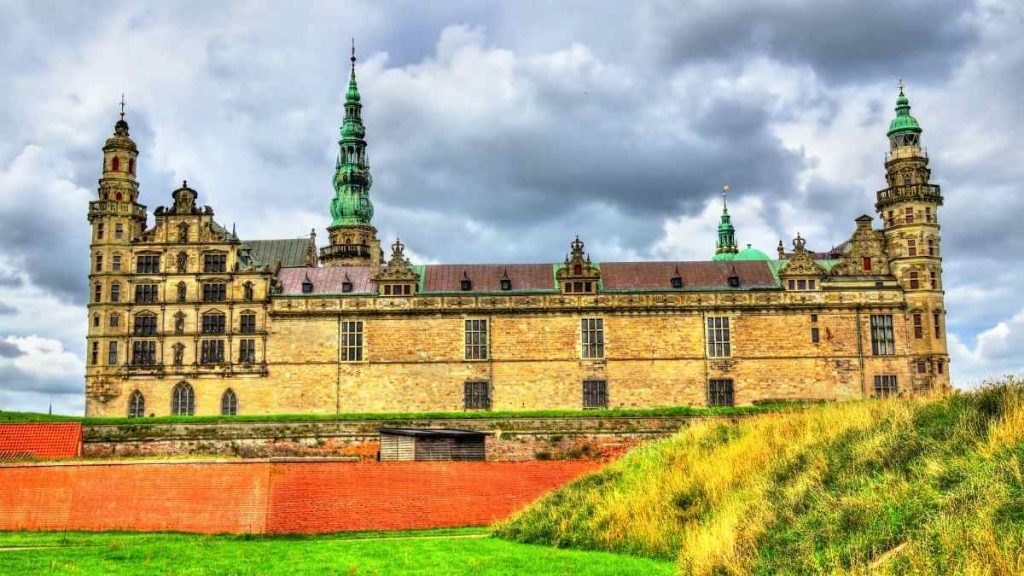
Historically, the castle controlled Baltic Sea trade through the Danish Straits during the Golden Age of Denmark. At that time, Denmark controlled territory in Southern Sweden and had castles on both sides of the waterway to collect a hefty toll from merchants. Today you can explore the ramparts, gun towers and dungeons of the castle as well as the chapel and royal quarters.
Pin it for later!
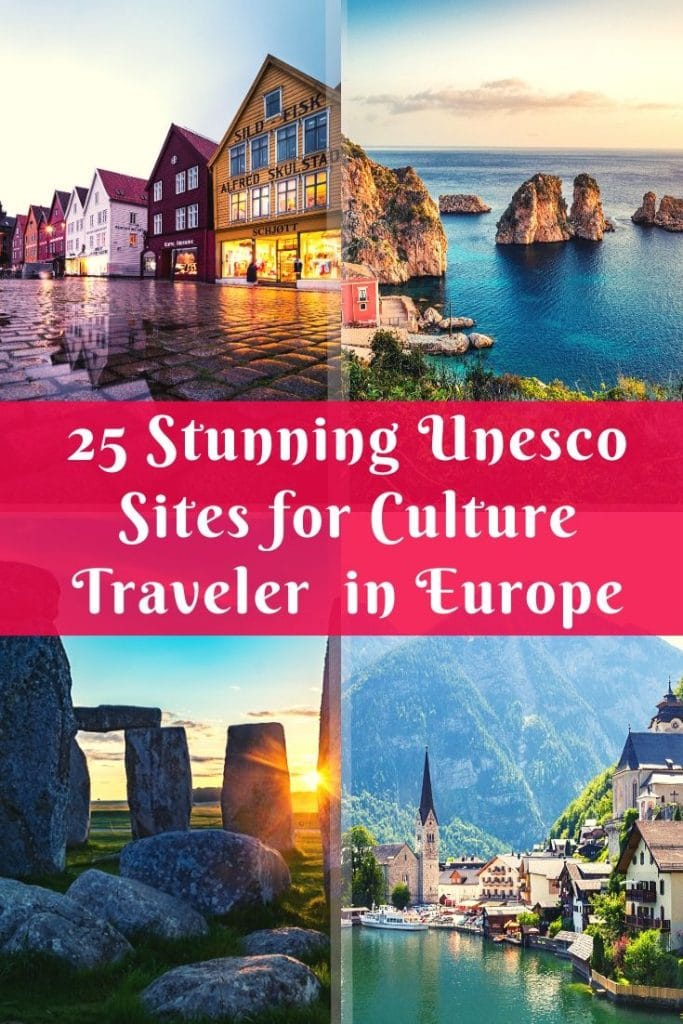
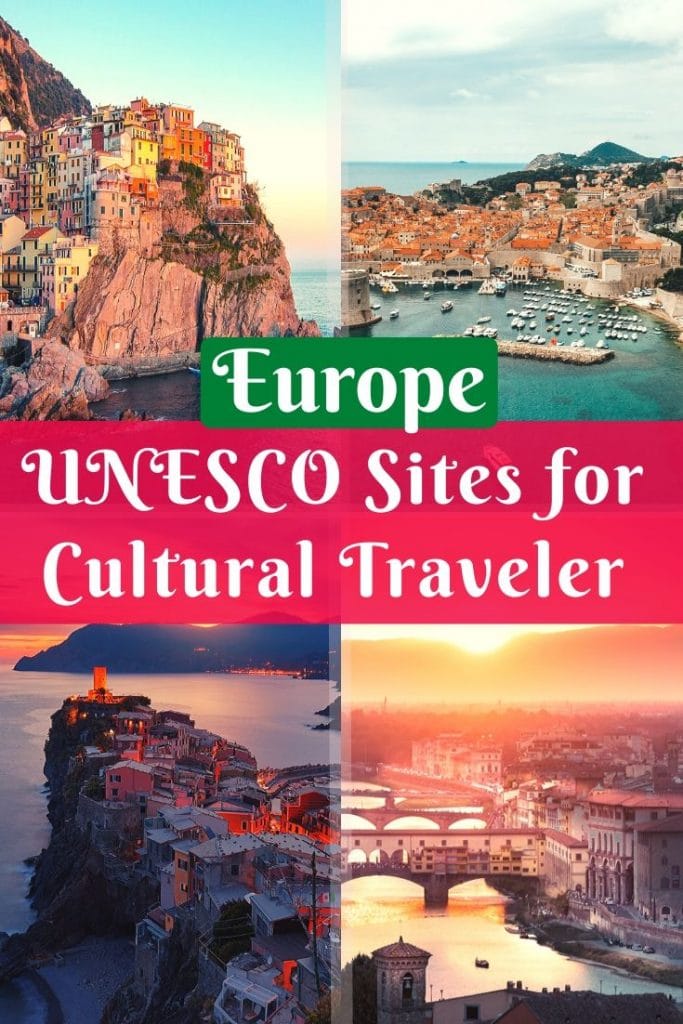
This post may contain affiliate links. Please read the disclosure post. If you have liked the article, you may support it by buying using these links without any extra cost to you.
Let’s stay connected on Facebook, Instagram, Twitter! You may also consider joining my mailing list. I send travel and photography related emails only once a month!
Amazing post. So many travel inspirations to keep for when we’ll be able to travel again!. You made me want to explore Europe 🙂
Well since I’ve only been to 6 of these it looks like I’ve got some work to do. There good thing is I’ve at least seen all the ones in my home country of the UK. I guess I have a trip to Europe to plan now
I have been to a number of these locations but have missed quite a few. This list would have been useful when I was travelling in Europe. They are all interesting with unique histories.
Absolutely stunning pictures and fantastic historical summaries. Thanks for reminding us about the work of UNESCO.
Amazing list. I liked the church village. I thought those were so interesting!
Thanks for having me in this collab! I loved sharing about my experience with Rocamadour and reading the other’s recommendations!
Fantastic post with some great ideas – it will take a long time to see all these UNESCO sites, but certainly worth trying one day…
A great list! Have been to many of those, but would love to visit the rest of them, especially Romania! 🙂
What a great list of beautiful buildings! I’ve been to many but so many more to explore especially liked the one in Georgia!
This post reminds me of how lovely Europe is. I am so lucky to live in such a great part of the world, but I have only been to about half of these places. I hope to get to some more of them.
Awesome post! I can’t believe I’ve only been to 5 UNESCO sites and I’ve been living in Europe for over 5 years! I also love that you shared a bit of history for each site. I will be saving this for sure. 🙂
I love visiting UNESCO sites! One of my favorites on here that I’ve been to is Hallstatt, Austria. It was truly beautiful. I’d love to visit some more of these places someday.
These are also so beautiful! I’m particularly fascinated by Meteora in Greece. It looks something out of a fairy tale and it amazes me that people managed to build something in such a precarious place.
I’ve only been to a few of these, so it looks like I am going to have to hop on some flights when we can all travel again! Amazing reviews and photos!
Your pictures are so beautiful! I’ve been to a couple UNESCO sites but there’s so many more I want to see from your list. Rocamadour is on my top!
Omg this just made me realize how much of Europe I have not experienced yet! Great content!
Fabulous post. This is a really comprehensive list.
Hi! I love how informative and great your articles are. Can you recommend any other blogs that share recipes of Indian Curries or authentic Indian cuisine? Thanks a lot!